

10 Free Graphic Organizer Templates for Any Subject
Different lessons require different types of content to help students learn. Here are 10 free graphic organizer templates to use for any subject.
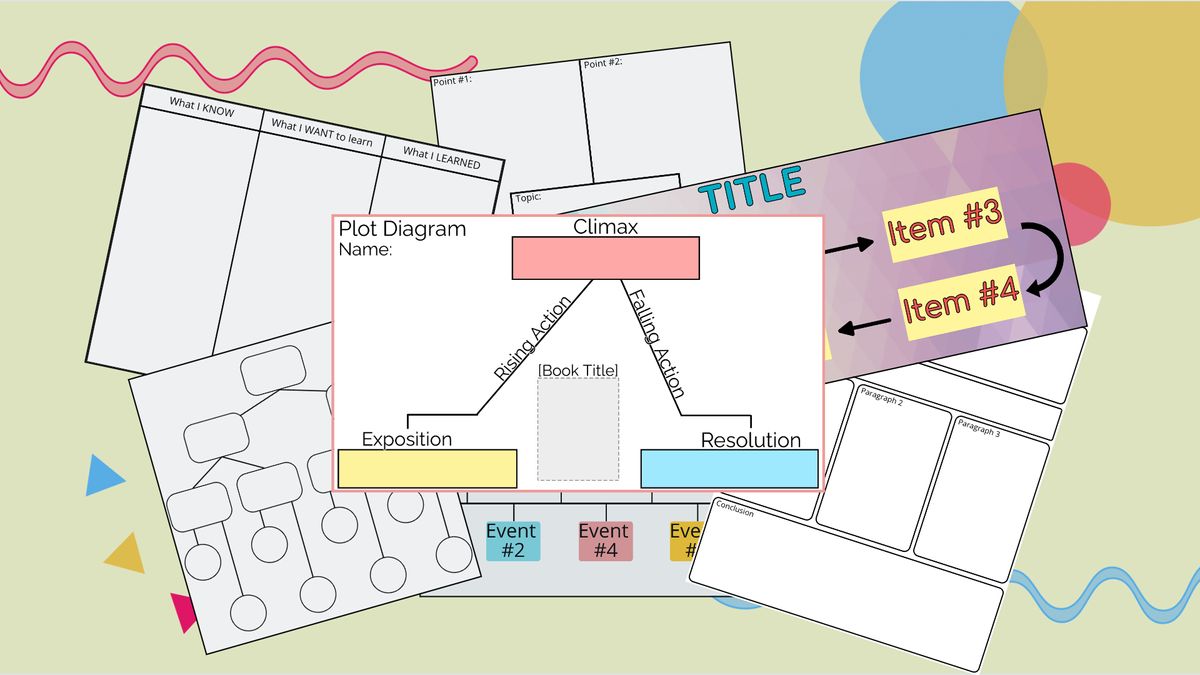
Most students are returning to the classroom in Fall 2021, but everyone’s learning methods have had to change over the past two years. It’s important to adapt as an educator with new techniques , digital materials, and fresh content to keep students engaged .
For any subject, graphic organizers provide effective ways to introduce, teach, develop, and test new material. But different lessons require different types of content to help students learn best. I’m going to give you 10 free graphic organizer templates to use for any subject – just use the Make It button to customize, label, and download your graphic organizer.
- Venn Diagram
- Plot Pyramid
- Brainstorm Chart
- Concept Map
- 5-Paragraph Essay Outline
- 4 Square Writing Chart
1. Flowchart
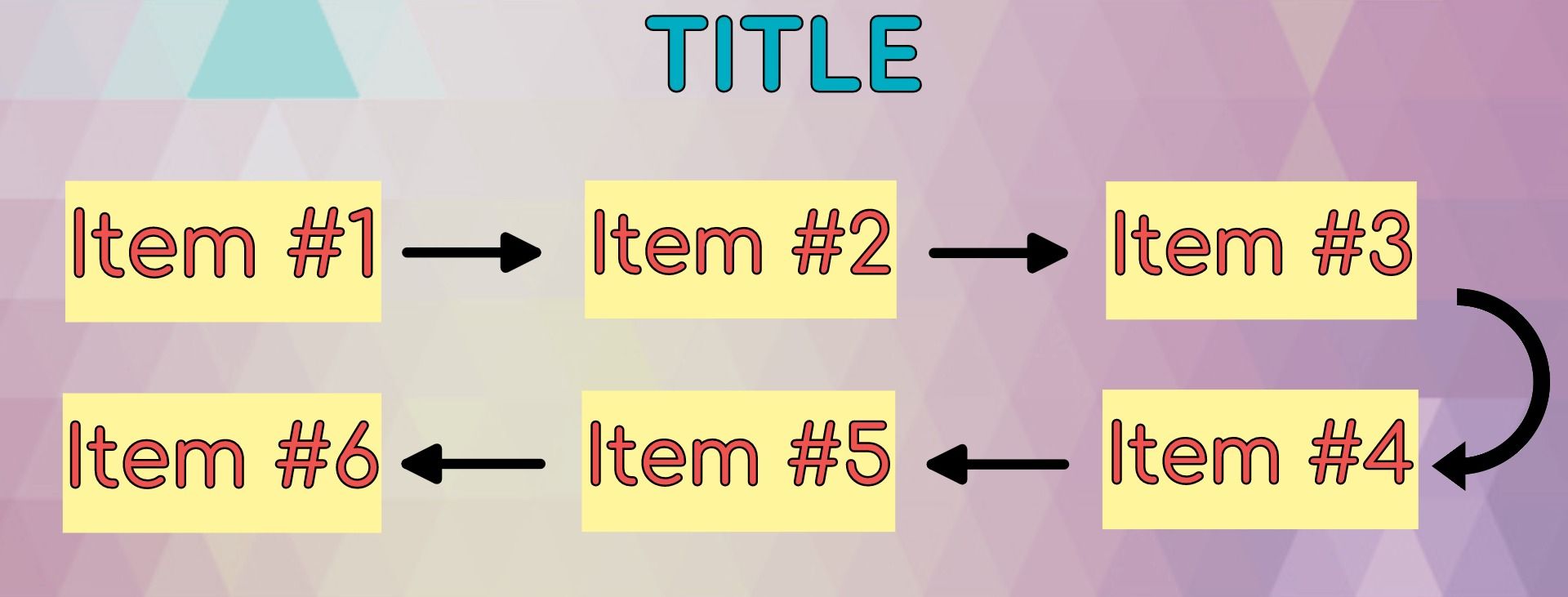
The Flowchart is one of the most versatile and recognizable forms of graphic organizer out there, ideal for project planning and science experiments. A goes to B goes to C goes to D . With this version, you can copy and paste sections of the chart to make it as long or as short as you need, label each section with specific details, and add a title and other information for your assignment.
2. Timeline
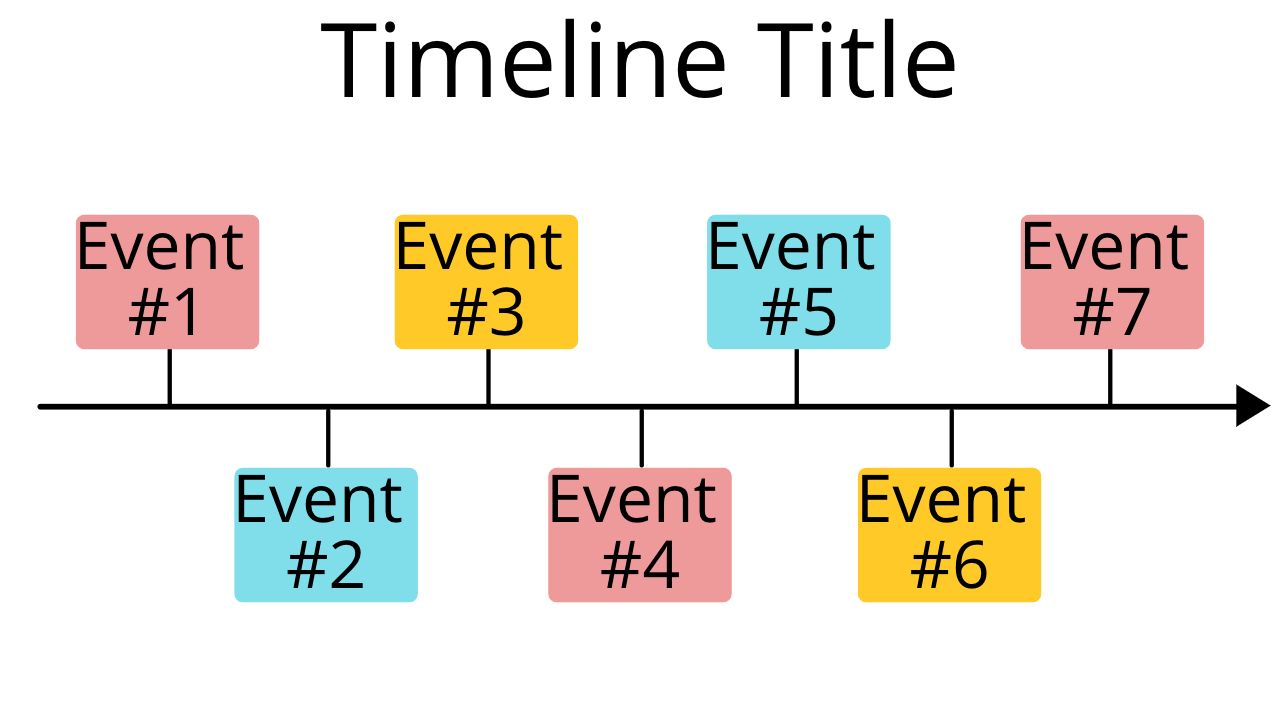
The Timeline is similar to the flowchart , with events spaced out along a single path . In a Timeline, however, the intervals between the events is important to the graphic organizer as a whole. Using this template, you can drag events from one point of the Timeline to another, and add text labels for years and events.
3. Venn Diagram
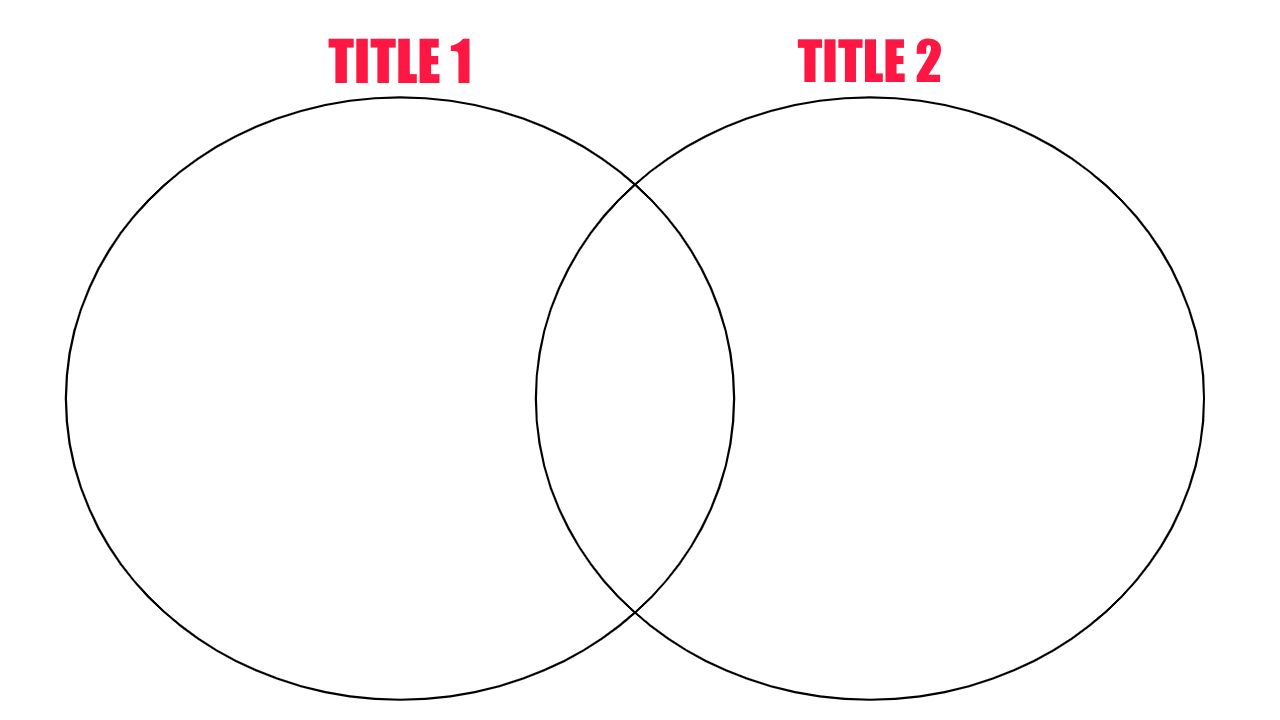
One of the most widely-used graphic organizers, the Venn Diagram provides a simple way for students to compare and contrast 2 or more distinct ideas. With this template, you can copy and recolor the Venn Diagram circles to compare any number of items with each other.
4. Plot Pyramid
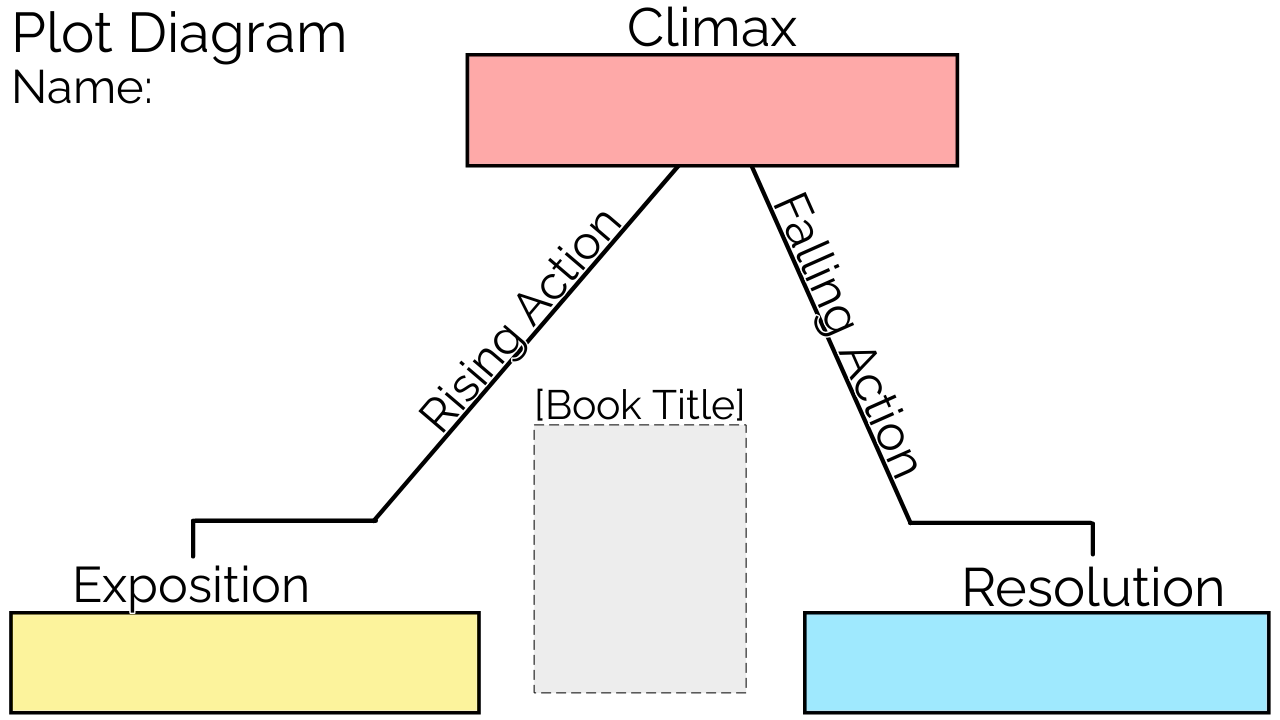
This graphic organizer is most commonly used in elementary and middle school English, language arts, and literature classes. It’s used to identify and map the various stages of a plot arc , from exposition to conclusion. Use this template to title the Plot Pyramid and add any other relevant information you need.
5. Brainstorm Chart
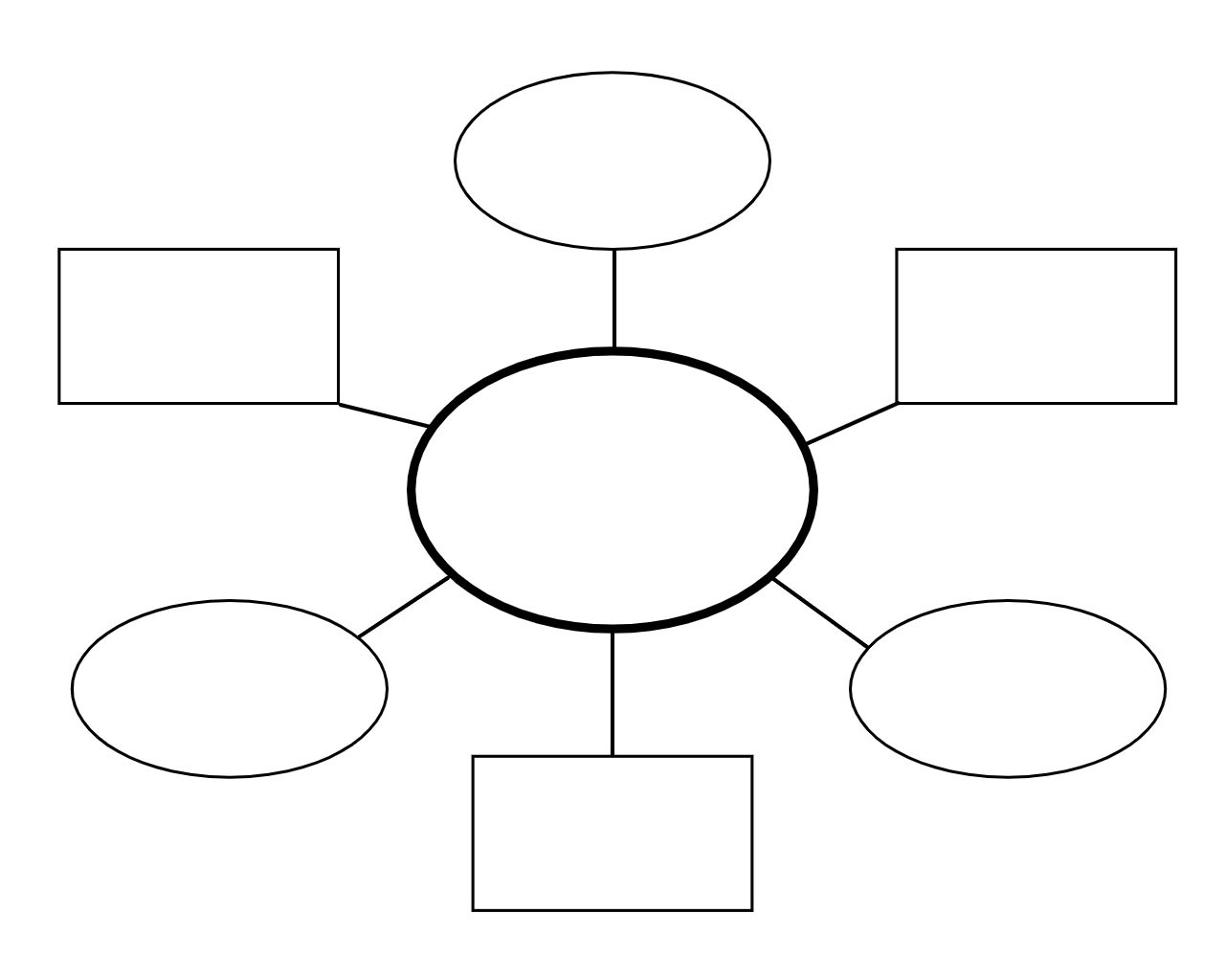
The Brainstorm Chart is a far more freeform type of graphic organizer than most others on this list, and can be arranged almost any way you like. All it requires is a central idea or “problem” to solve, along with an array of other ideas and concepts that are connected to it, and supporting details for these connected points. The freeform nature of the Brainstorm Chart allows students to think creatively and originally on any subject.
6. Concept Map
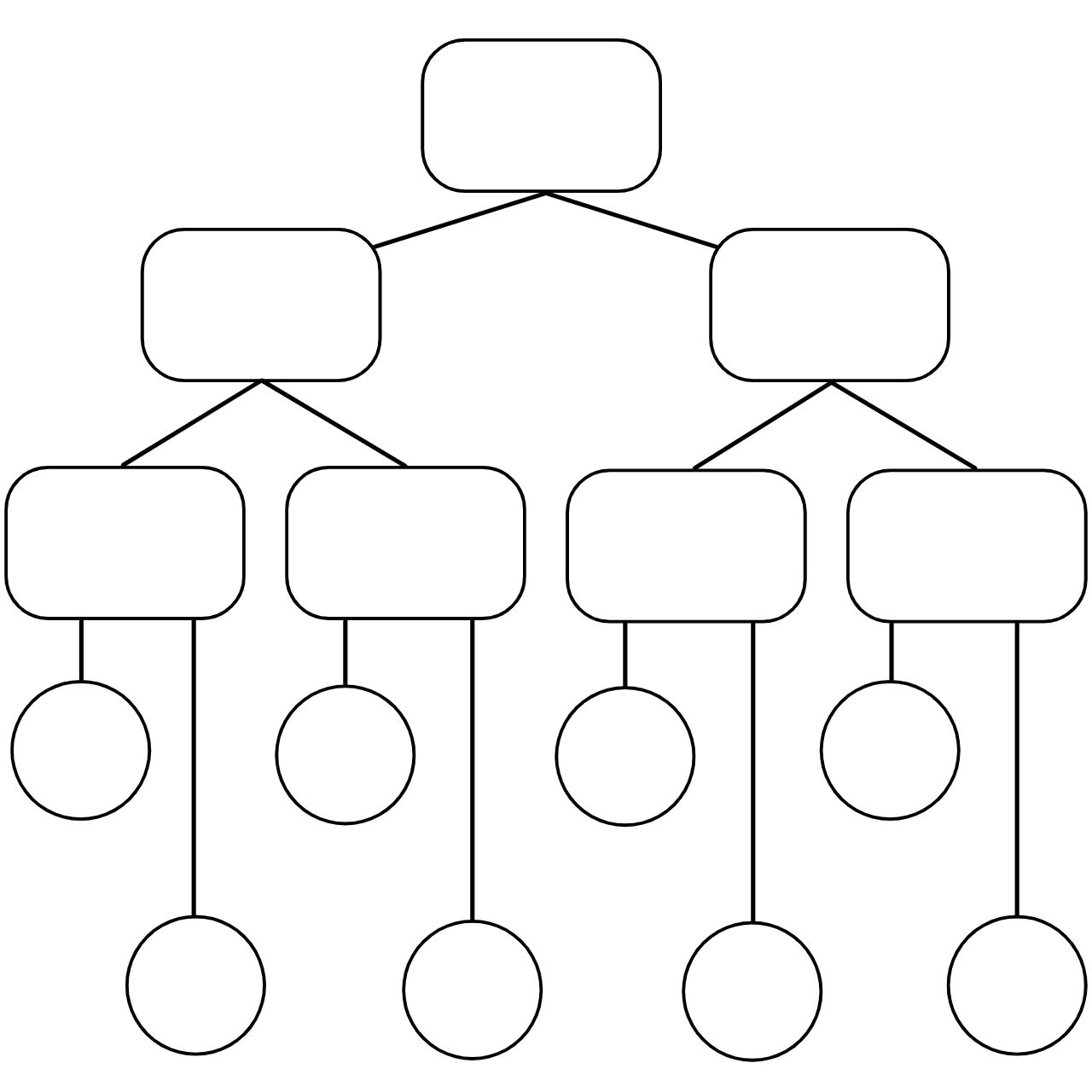
The Concept Map is similar in form to the Brainstorm Chart, but with slightly more limitations on how it’s used. It’s used to illustrate the relationships that exist between various related concepts , filling in different sections of the organizer to show how the different parts are connected. The Concept Map is perfect for introducing students to a new set of related vocabulary terms in any subject.
7. 5-Paragraph Essay Outline
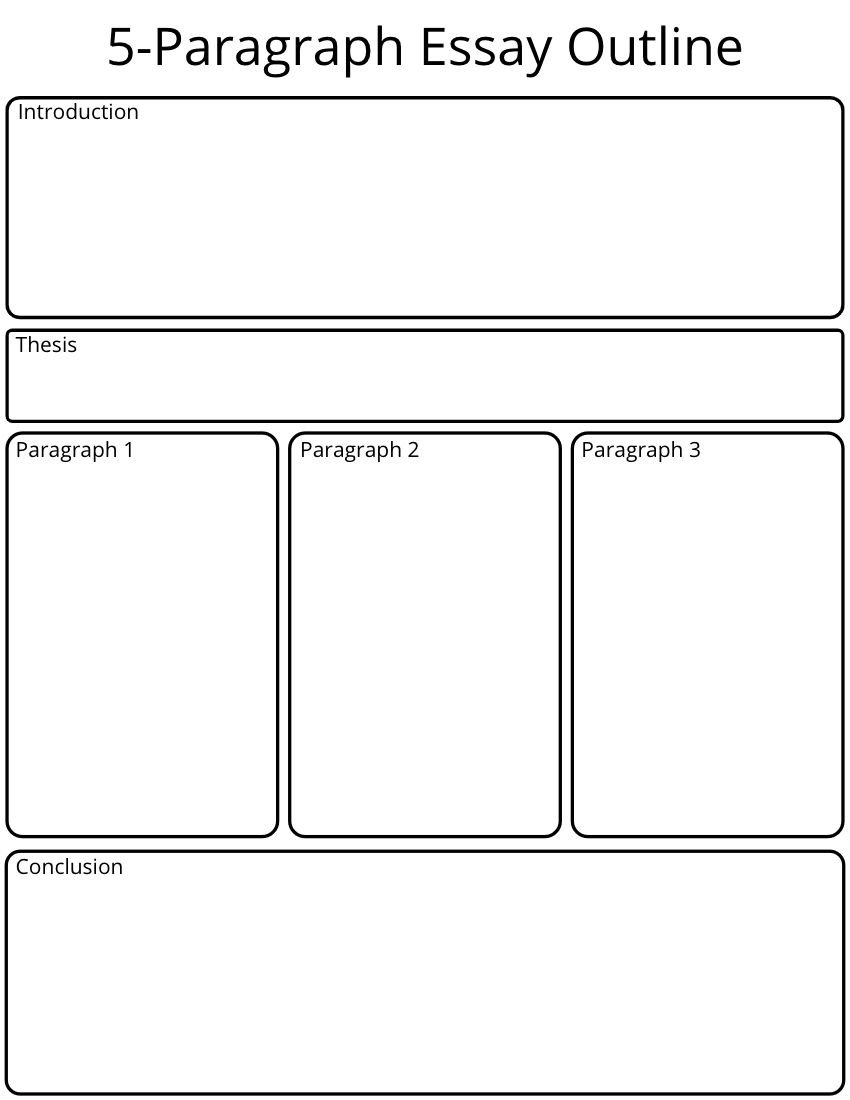
While some of your students may not remember the 5-paragraph essay too fondly years later, it’s an important step in developing their persuasive writing . This classic 5-paragraph planner is perfect for helping students construct their arguments, counter-arguments, supporting data, and conclusions before they put pen to paper.
8. 4 Square Writing Chart
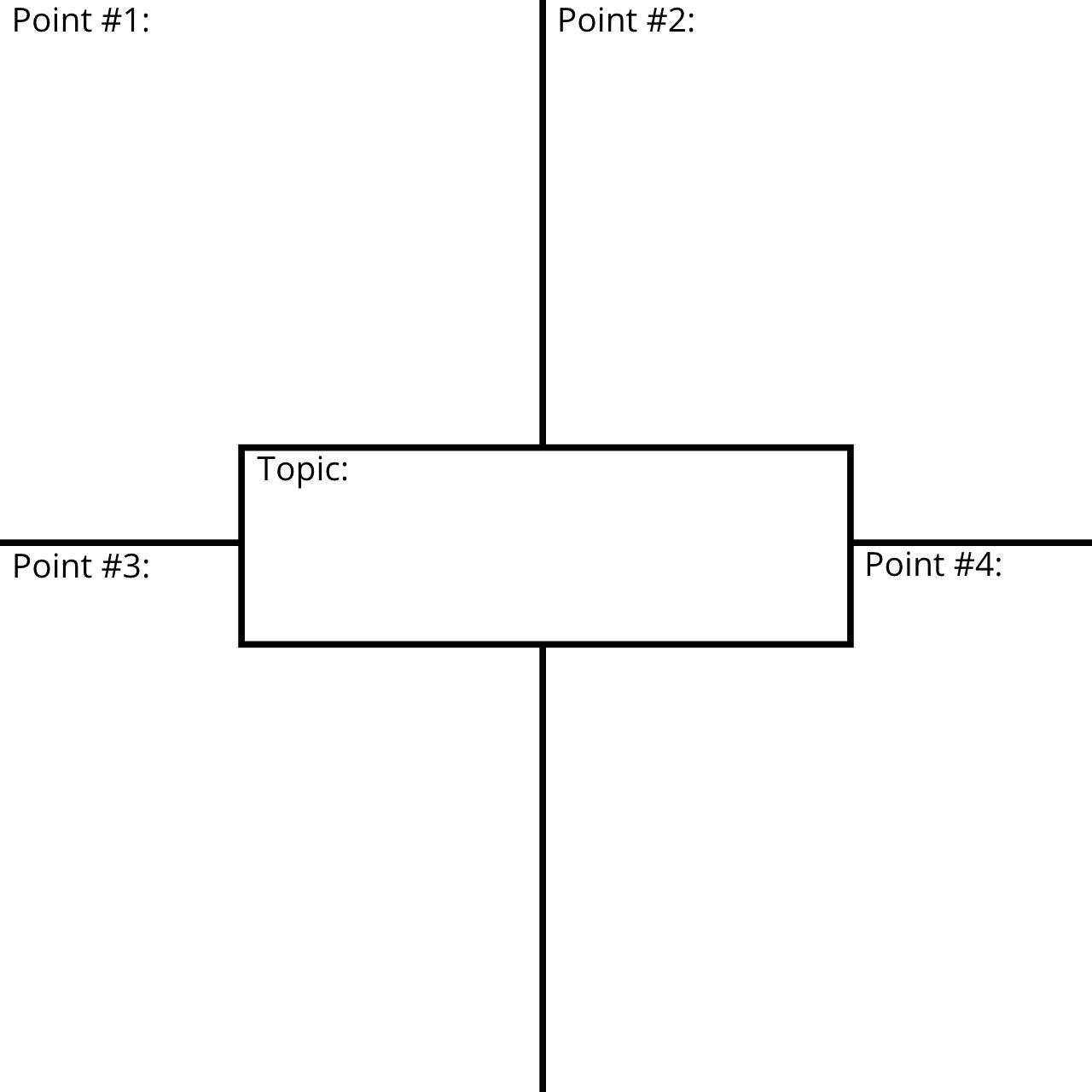
The 4 Square Writing Chart is similar to the 5-paragraph essay outline, it gives space for looser organizational styles and more creative types of writing structure . The central area contains the main idea or argument, and the surrounding squares are filled with supporting arguments, sections of a narrative essay, personal experiences, or several sides to the same story.
9. Story Map
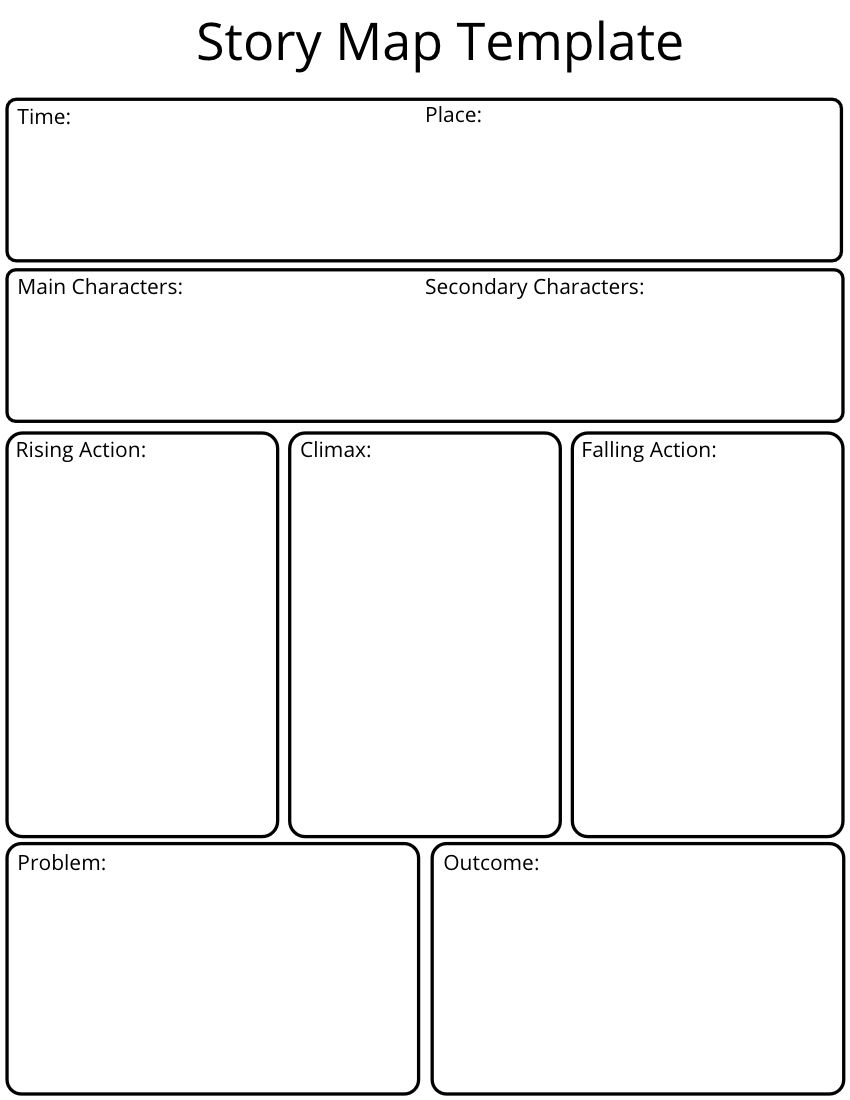
The Story Map is used for a similar purpose to the Plot Pyramid, but with a broader approach to narrative plot arcs. In the Story Map, students not only recount the plot progression of a story, but detail the setting , characters , and central problems and outcomes . There are dozens of ways to organize your own Story Map, so I recommend you use this template to include whatever areas are most important for your students to identify and analyze.
10. KWL Chart
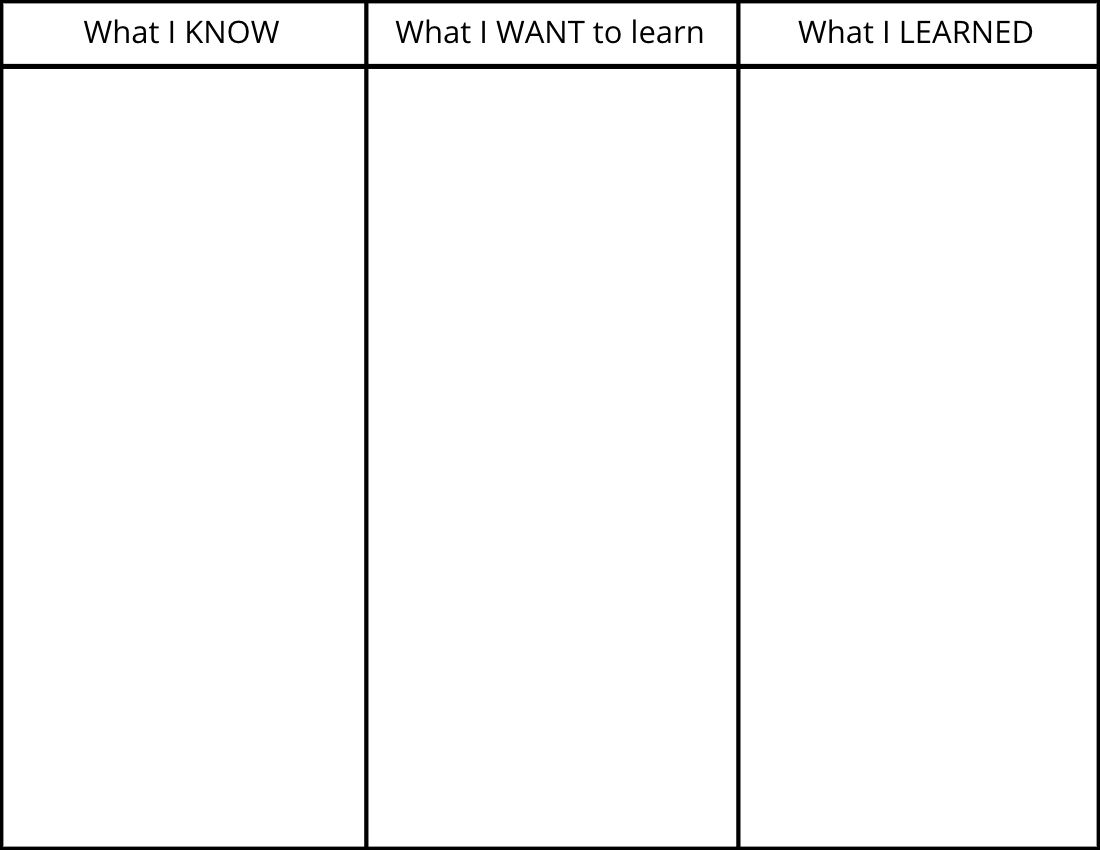
KWL Charts ask students to write on three different things before and after completing a lesson, activity, or reading: what they Know already about the topic, what they Want to learn from the lesson, and, afterward, what they Learned from the experience. It creates more of a big-picture exercise than most of the graphic organizers on this list, allowing students to identify what they gain from their lessons.
I hope these graphic organizer templates help you engage students effectively in every subject you teach. For more tips and tutorials on creating great digital content in 2021, check out the Kapwing YouTube channel or read through some related articles on education materials:
• 10 Back to School Frames for Fall 2021 • The 4 Best Ways to Learn Video Editing Online • How to Add Subtitles to a Lecture Video • How to Make a Frayer Model Online

How to Make a Graduation Video for TikTok or Reels

How to Make Educational Videos Engaging
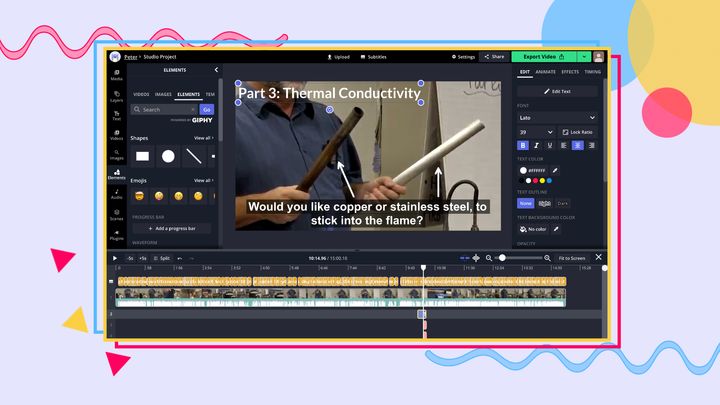
How to Create a Lecture Video Online

Free Editable Essay Graphic Organizer Examples
Essays are complex and large write-ups that are not easy to intercept. That’s why it is better to use an essay graphic organizer to visualize your complex structured outline in a simple manner. In fact, there is nothing better than some free graphic organizer examples that save both your time and effort. So, let’s have an overview of this essay organizers and free example templates.
1. What is Essay Graphic Organizer
An essay graphic organizer enhances your research with visual elements. It helps the writer to correlate facts, observations, and notions. On top of that, it outlines the essay and provides an organized strategy for the writer.
A graphic organizer for writing helps the writers to tackle hard and long essay formats. A writer can use its visual aid to complete the write-up step by step. A graphic organizer for essays has different types based on primary functions.
- An Outline Based Essay Organizer
These types of essay organizers have at least 3 thesis. The whole story revolves around these. Moreover, the organizer includes specific supporting details and subtopic names that make the way crystal clear for writers. However, these organizers do not need much essay explanation. Most indications are worldly phrases that direct the attention toward thoughts and observations.
- A Contrasting Essay Organizer :
As the name indicates, it helps the writer to organize varying thoughts about topics and compare them. Moreover, it helps the writer to collect, conceive and portray the information ahead of time. The writer can use it for two collective primary topics or a single point from both topics. In both cases, the essay organizer will help them take visual notes and use them to their advantage while writing.
- Organizer For A Persuasive Essay :
The persuasive essay organizer helps the writer to persuade an audience toward a single topic. It includes three or more supporting details for the topic. Furthermore, the organizer includes written evidence for those details that help prove the point.
2. The Essay Graphic Organizer Examples
Using an essay graphic organizer for writing brings credibility and flexibility to your essays with extensive research. Essay writing is a tough job, especially if it has more than one subtopic.
Essays require tons of details. All that quality is up to no good if it is not organized and well structured. An essay organizer for writing helps you understand how the minor details contribute to overall concepts. With thorough research and long formats, essay writing may become dull. However, an organizer helps you to perfectly structure your thoughts with appealing visuals that make them engaging and far less challenging.
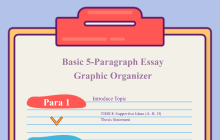
Basic 5-Paragraph Essay Graphic Organzier
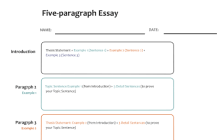
5-Paragraph Essay

Expository Essay Graphic Organizer
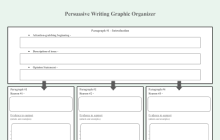
Persuasive Essay Graphic Organizer

Essay Graphic Organzier
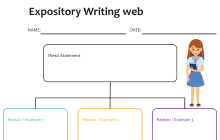
Narrative Essay Graphic Organizer
Example 1: 5 Paragraph Essay Graphic Organzier
The most common type of essay writing format is a 5-paragraph essay. Essay graphic organizer for writing helps organize all those 5 paragraphs and insert valuable information inside them. It includes the first paragraph section in which the writer inserts the topic sentence and at least three thesis statements. The upcoming three paragraphs briefly summarize those statements and provide at least three pieces of evidence for each thesis. Finally, the last paragraph repeats the main statement and includes an overall concluding statement. Moreover, every thesis detail includes a conclusion statement that conceives the entire concept.

Example 2: Printable 5 Paragraph Essay Graphic Organizer
It is also the type of essay organizer writers use to organize the outline of a 5-paragraph essay format. Its first paragraph is of introduction which includes with a thesis statement instead of a topic sentence. The statement inside the paragraph includes three supporting examples with itself. Moreover, the second paragraph has a topic sentence that the previous thesis supports. Plus, it has individual evidence details that prove the topic sentence true. The third paragraph includes a thesis statement that correlates with the previous and upcoming topic sentence. Finally, the last paragraph has the essay's main idea and a concluding statement that proves the point.

Example 3: Argumentative Essay Graphic Organizer
This template solemnly deals with the expository template of the essay. It focuses on the essay's three most basic parts: the introduction, body, and conclusion. Moreover, the writer evaluates the selected topic in it with examples and evidence and closes the argument clearly and concisely. The exemplary diagram includes 2 separate boxes in the introduction sections. One of them is for the hook that engages the audience, whereas the other depicts the essay's main idea. Inside the body section, the writer briefly lists three examples, each with individual supporting details. Finally, the conclusion includes two sections; one for reviewing and rewriting the central concept and the other to input the closing details of the essay.

Example 4: Persuasive Essay Graphic Organizer
This example diagram of the essay graphic organizer for writing helps to persuade a general or specific audience toward your point of view. The primary purpose is to enlist your opinion and evaluate it with the help of numerous supporting details. As for the organizer, it is for a 5 paragraph format. The first one has an engaging beginning, a summary of the issue, and your opinion. Furthermore, the next 3 provide different reasons that support your opinion. Moreover, the section also includes evidence in the form of examples and textual details that support every reason individually. The last paragraph is a conclusive one that restates the opinion, summarizes all three reasons again, and gives a CTA (call to action) at the end. However, you can ditch the CTA and add a simple closing statement that supports your opinion.

Example 5: Informational Essay Graphic Organizer
This type of organizer is for essays having more than one main idea. The organizer's interface has several colors that make it engaging and appealing. Due to the color, it is referred to as a Rainbow essay organizer. A big individual box includes the whole organized outline of the essay. The writer has to briefly write all three ideas in it and support their point of view. Moreover, the organizer includes an introduction and conclusion description. At last, there is a final draft section that concludes the whole essay and supports either all three or one suitable main idea.

Example 6: Narrative Essay Graphic Organizer
The expository essay is a genre that requires the student to investigate an idea, evaluate evidence, expound on the idea, and set forth an argument concerning that idea clearly and concisely. The below expository essay web diagram is created using EdrawMax Online and shows blank spaces for Thesis Statement, Example 1, Example 2, Example 3, Details about all the examples, and argumentative points. Expository writing gives facts and information about a topic, and as the web diagram suggests, a good expository essay introduces the main idea and develops it with facts and supporting details.
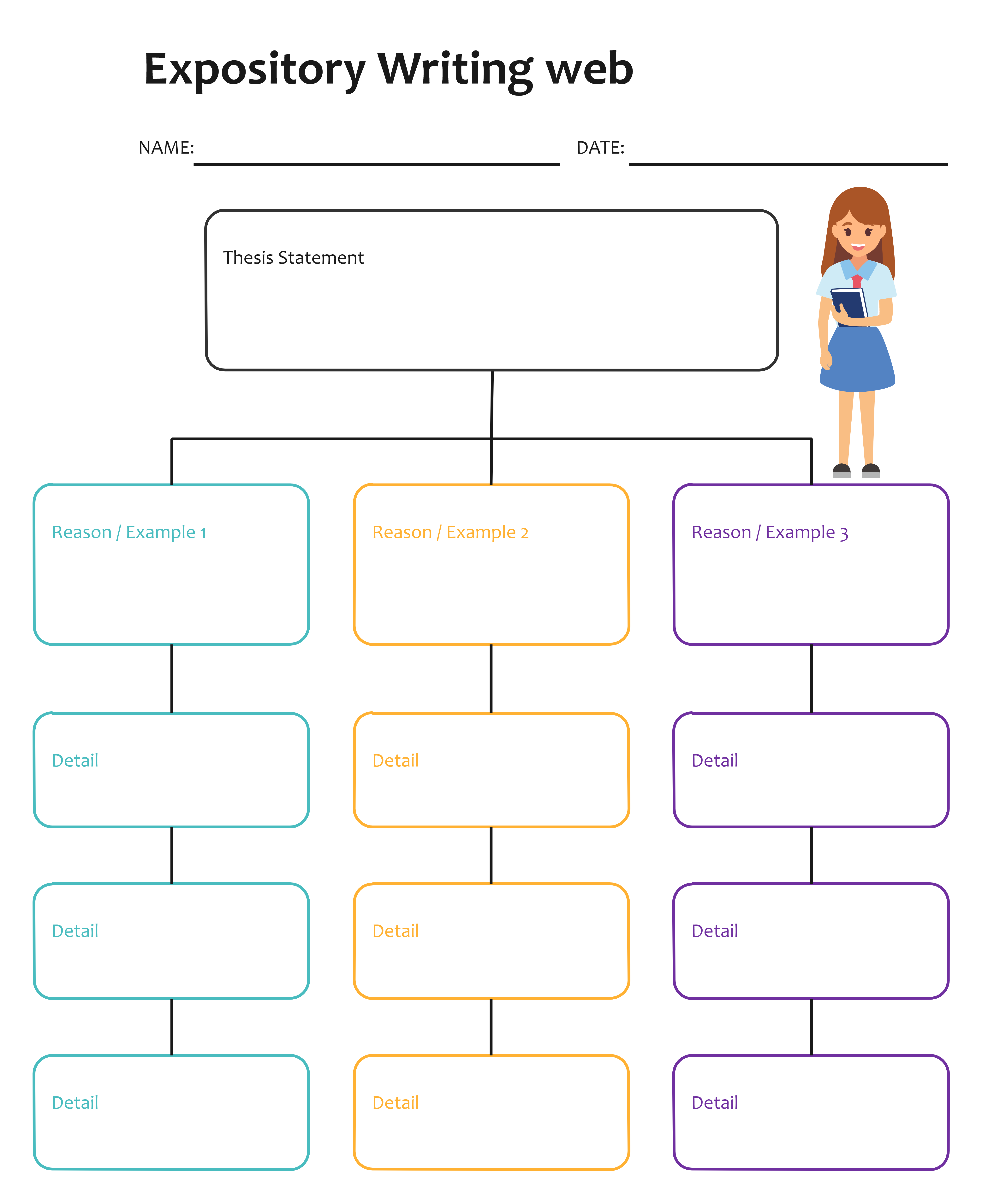
3. How to Make an Essay Graphic Organizer
Graphic organizers are the modern way of learning. With passing time, people are using them in every type of write-up. Therefore, it is better to understand its production process so that you can make one specifically for your essay. The online production software uses four simple steps to generate a graphic organizer for essays.
Step 1 - Head on to EdrawMax Online or download EdrawMax . Make an account and log in to it.
Step 2 - Once inside, you can start creating the graphic organizer on a blank edit sheet or readymade essay organizers, such as mindmaps and spider maps. However, this process is time-consuming. If you want an easy solution, head to the main menu on the left, look for Templates Community , and click on it.
Step 3 - Clicking on the Template Community option will take you to a social network of designers and a general audience like you that post templates daily for public use. You can search for your very own template and duplicate it onto your sheet using the button Duplicate.
Step 4 - Finally, start customizing it as you like. You can change the font, color, and components. Moreover, you can add new ones if you like. Once you are done and satisfied, export and share your template with others using the Button Publish present on the top right corner.
4. Online Graphic Organizer Maker
Traditional ways are gone when you had to work extensively for a simple diagram in lining software. Online graphic organizers like EdrawMax made graphic organizer designing much easier and less time-consuming. All thanks to its easy-to-use interface and basic yet helpful tool kits, designing a diagram is possible for every individual with basic knowledge.
Moreover, EdrawMax saves a lot of effort and time with the help of readymade templates. This online graphic organizer maker is suitable for any type of consumer to generate any variation of the graphic organizer. Its biggest pro is the Templates Community , with thousands of readymade templates for users. In this social biome, you can not only pick the one that suits you well but share your ideas with the community as well.
5. Key Takeaways
The visual aid of essay graphic organizers helps the writers to organize their researched facts and general thoughts according to references. Moreover, it gives a direction to the audience and the writer for the essay. As for its usage, the writers are helping themselves with it in their professional careers. Moreover, it proves exponentially efficient in the academic field for students. When it comes to essay writing, it helps in both of these by establishing a relevant and valid connection. Plus, communicating our thoughts with visual sketches and doodles is less boring and more engaging.
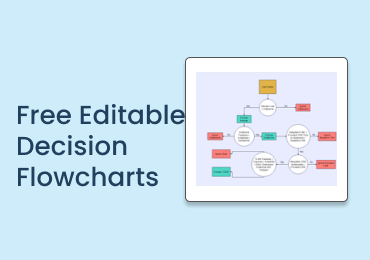
Free Editable Decision Flowcharts
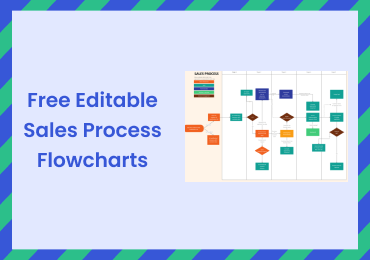
Free Editable Sales Process Flowcharts

Free Editable Flowchart Infographic Examples
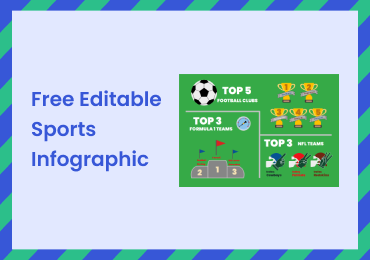
Free Editable Sports Infographic Examples

Free Editable Roadmap Infographic Examples
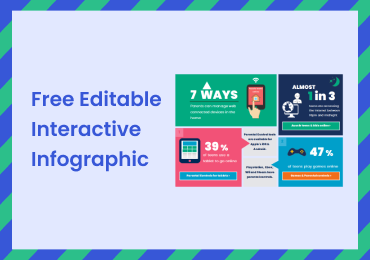
Free Editable Interactive Infographic Examples

Using Graphic Organizers for Writing Essays, Summaries and Research

Ask any student – essay writing is one of the most despised tasks of their educational career. Perhaps there is so much displeasure associated with the task because it’s perceived as too linear – there isn’t enough visual and creative appeal. But if you use graphic organizer for writing essays then you can make writing enjoyable – or at least less terrible.
Not only enjoyable but graphic organizers (or diagrams) can make the writing process a snap. They’ll help you think outside the box, draw conclusions you wouldn’t normally observe, and make the entire process faster and more efficient.
Why Use Graphic Organizers for Writing
The phrase “graphic organizer” is just a fancy way of saying “diagram” or “visual aid.” Basically, they are a visual representation of the information you’ve acquired in the research process. There are quite a few reasons why you should use them when writing essays or summaries.
- Helps you visualize your research and how elements connect with each other
- Enhance your essays, summaries and research papers with visual elements
- Track correlations between your thoughts, observations, facts or general ideas
When it comes to essay writing, the most common graphic organizers are webs, mind maps, and concept maps .
Using Webs for Brainstorming
Webbing is a great way to see how various topics are interrelated. This graphic organizer is particularly useful during the brainstorming step of the writing process.
A web can sometimes get a bit messy. Usually, there are lots of arrows to connect overlapping ideas. However, even with lines crisscrossing every which way, it is still a great way to visualize your thoughts. If you’re using an online diagramming software like Creately you can overcome some of this because we automatically arrange the object for you.
Once you’ve created a map to document all your ideas and establish connections, you can easily transition to other forms of diagramming to better organize the information.
For example if you’re writing a research paper about the food web of the Australian bushes you can start creating a food web diagram similar to the one below. This way you can easily visualize the web while writing the paper. This is a simple example but graphic organizers become even more important when the subject gets complex.
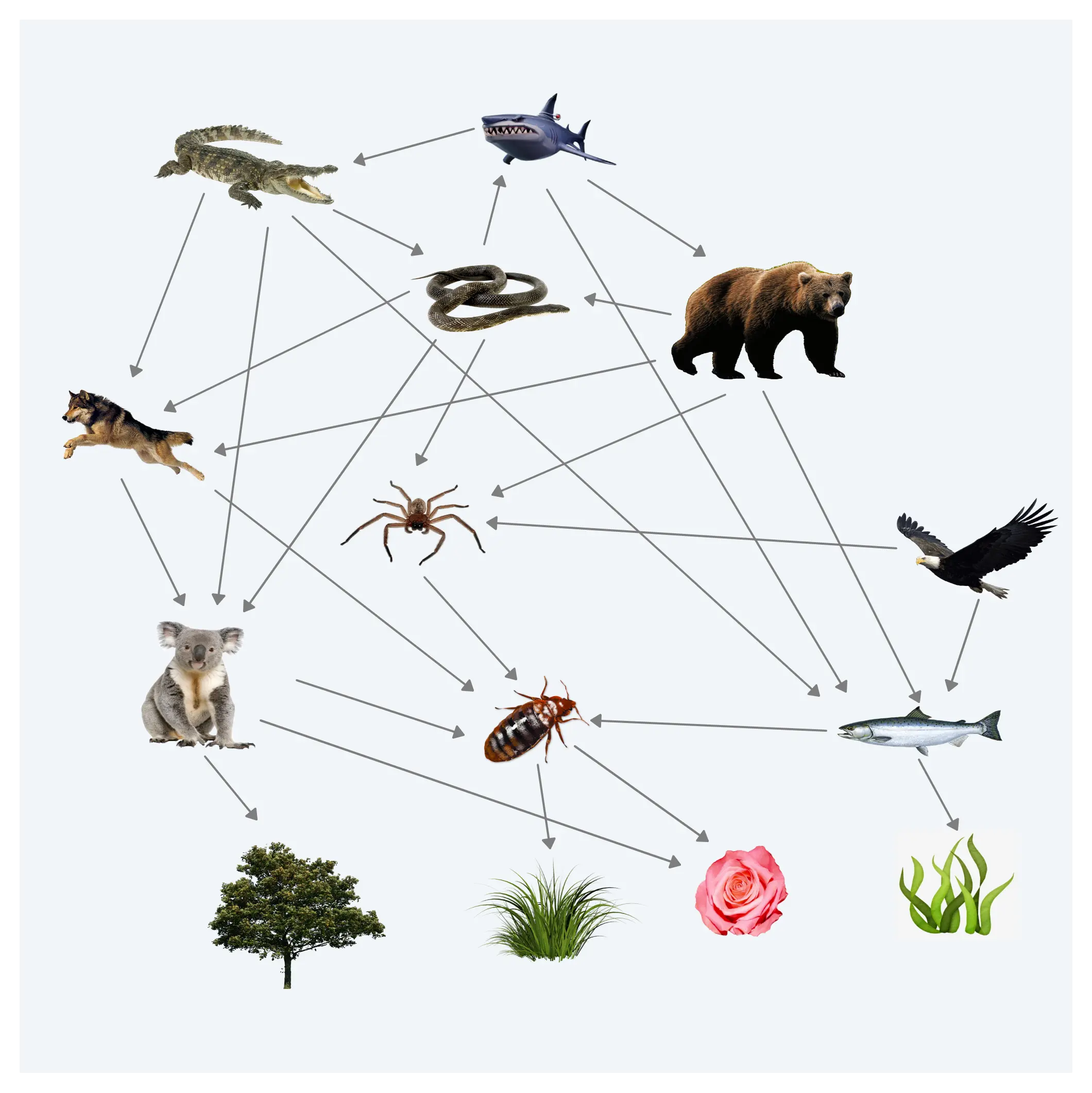
Although simple this example shows the importance of using graphic organizers for writing summaries. A comprehensive diagram pretty much does the summation for you.
Using Mind Maps as Graphic Organizers
Mind maps are a great way to depict a hierarchy. What is hierarchical organization ? The concept is simple: a singular topic dominates with each subsequent idea decreasing in importance.
Usually, the mind map starts with the thesis (or main idea) at the center. From there, you can branch out with your supporting evidence.
Use this process to replace your traditional note taking technique – note cards, outlines, whatever. You’ll quickly realize a mind map is a great way to formulate the structure of your essay. The thing to note here is that the nature of the mind maps force you think about sub topics and how to organize your ideas. And once the ideas are organized writing the essay become very easy.

Above is a mind map of a research proposal. Click on it to see the full image or you can see the fully editable template via this link . As you can see in this mind map the difference areas of the research proposal is highlighted. Similarly when your writing the research paper you can use a mind map to break it down to sub topics. We have more mind map templates for you to get started.
Concept Maps
A concept map will help you visualize the connection between ideas. You can easily see cause and effect – how one concept leads to another. Often times, concept mapping includes the use of short words or phrases to depict the budding relationship between these concepts.
If you look closely you can see that its very similar to a mind map. But a concept maps gives more of a free reign compares to the rigid topic structure of a mind map. I’d say it’s the perfect graphic organizer for writing research papers where you have the license to explore.
By creating a concept map , you can also see how a broad subject can be narrowed down into specific ideas. This is a great way to counter writers block. Often, we look at the big picture and fail to see the specifics that lead to it. Identifying contributing factors and supporting evidence is difficult. But with a concept map, you can easily see how the smaller parts add up to the whole.
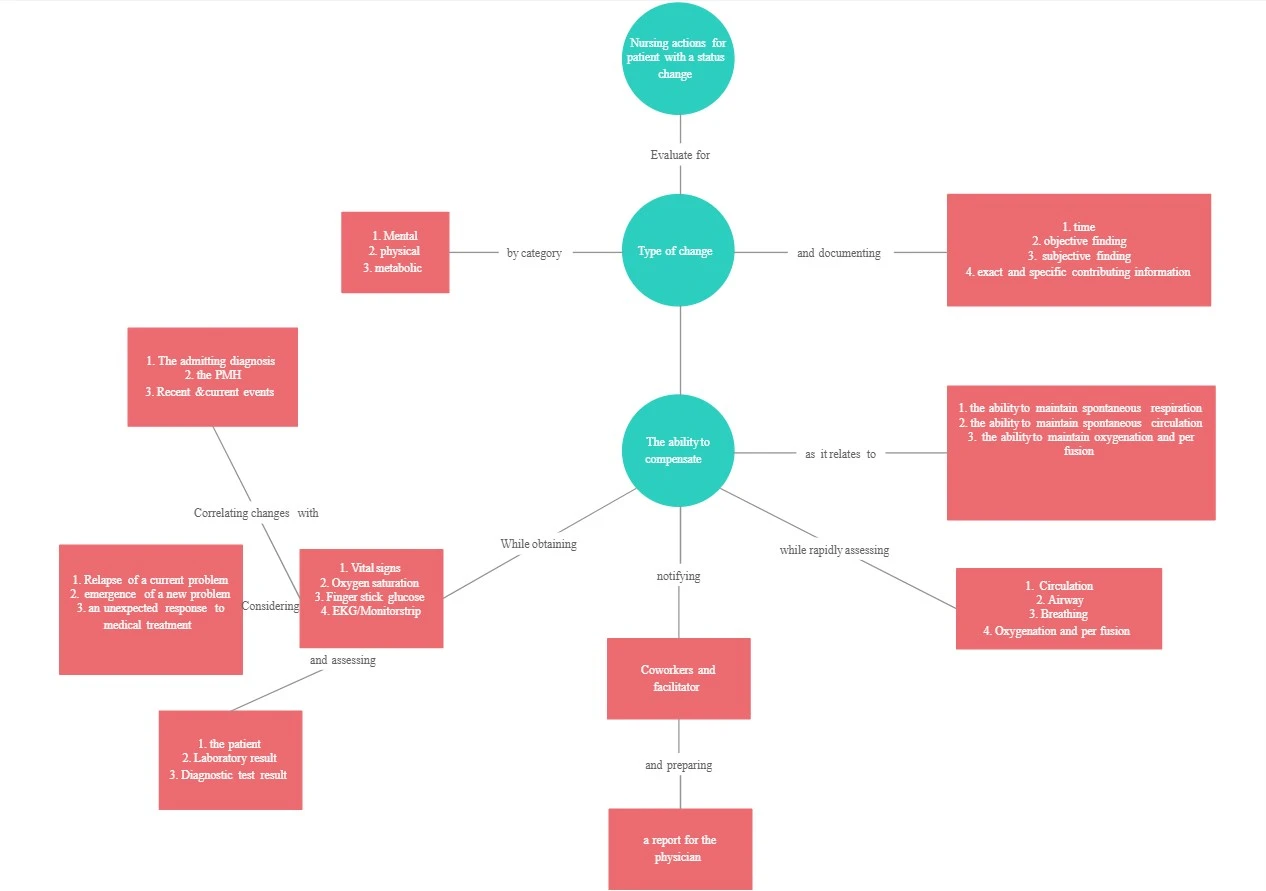
Why Bother With Graphic Organizers?
If you already detest the writing process, adding another step might seem insane. However, there really are several advantages of using them. If you haven’t already accepted the benefits of each individual diagram style, here are some more perks of graphic organizers in general:
- Quality essays are based on detail. No one is going to accept your opinions and reasoning just because you say so. You’ll need proof. And organizing that proof will require attention to detail. Graphic organizers can help you see that detail and how it contributes to the overall concept.
- Graphic organizers are flexible. You don’t need one of those giant pink erasers. You don’t need to restructure your outline. All you have to do is draw a few arrows and bam – the relationship has totally changed.
- No matter what you are writing about, a graphic organizer can help. They can be used to structure an essay on the Great Wall, theoretical physics, or Spanish speaking countries.
- If you write an outline, can you easily see how point A influences point X? Probably not. But if little thought bubble A is sitting out there all by itself, you can visualize the way it ties into point R, T and X.
- Some of us find it difficult to put our opinions, thoughts, and ideas into writing. However, communicating our feelings with little doodles and sketches is far less threatening.
- As a writer, our brain often feels like a 2-year-old’s toy box – a big jumbled mess. Taking that mess and putting it onto paper with some semblance of organization is challenging. Rather than trying to take your thoughts from total chaos to a perfectly structured list, just try to get them out of your brain and onto paper in the form of a diagram.
- A graphic organizer helps you establish validity and relevance. You can easily nix the ideas that don’t support or enhance your thesis.
The next time you are faced with a writing project, take a few minutes to explore the efficiency of graphic organizers. You can find a wealth of templates here.
Have you ever used a graphic organizer to structure an essay? How did it go? Do you have a diagram suggestion for the writing process that wasn’t mentioned here? Let us know!
Join over thousands of organizations that use Creately to brainstorm, plan, analyze, and execute their projects successfully.
More Related Articles

These are awesome guest posts contributed by our users and technology enthusiasts. Do you have something interesting to share? Want to get exposed to a massive tech audience? Check out our Guest Posting Guidelines to how to proceed.

How to Use Graphic Organizers to Write Better Essays
Lucid Content
Reading time: about 6 min
If you’re a student, there’s no way around the inevitable: You’re going to have to write essays. Lots of essays. In fact, the five-paragraph essay is so fundamental to the high school curriculum that it’s still used on the ACTs, and knowing how to recognize the organizational structure of essays will help you score higher on the SATs.
Even though it seems like a chore, knowing how to organize and write an essay can have a lasting effect on your life, from getting into a better college to scoring a better job to performing better in that job long after your high school days are over.
Here’s a secret: Using graphic organizers for writing essays can help you write better essays faster. (And don’t count yourself out if you’re an educator—you can offer these tools to help your students succeed.) We’ll show you exactly how to do it.
Why use graphic organizers
When ACT graders or teachers are looking your essay, they’re looking for very specific criteria; essentially, they’re looking at how well you’ve organized your thoughts. Many students don’t take the time to outline their essay structure before writing, and that always means a lower score on a test and a lower grade on the essay in class.
Using a writing template can feel like an unnecessary step in an already complicated process. If you need extra motivation to implement these organizers into your writing routine, consider all of their benefits. Graphic organizers can help you:
- Save time by showing you where each piece of the essay “lives.”
- Have more productive brainstorming sessions, either by yourself or with a group.
- Make connections between ideas and create a more cohesive argument.
- Pinpoint holes in your arguments and either adjust the thesis or find supporting statements.
- Keep track of your research.
- Organize your thoughts and come to interesting, more compelling conclusions.
- Stay in the right direction when you feel lost in a sea of words.
- Manage anxiety by converting the fear of a blank assignment into an action plan with a clear map.
With all those benefits, it’s hard to ignore how useful and vital graphic organizers are to writing. And once you’ve become adept at organizing your thoughts for something like a school essay, you’ll find that skill carries with you throughout your life, whether you’re trying to become a more intelligent debater to negotiate prices. It goes beyond just the essay to becoming a better thinker. And it starts with a simple template.
We’ll walk you through several use cases for graphic organizers and provide templates for you to download and fill in when you’re ready to write.
Brainstorming graphic organizers
Brainstorming is important, not only to come up with ideas for topics but to determine what information you need to include in the essay once you’ve determined your topic. Though many think of brainstorming as just freeflow thinking, brainstorming is most productive when you work within specific parameters.
That’s why essay brainstorming graphic organizers are useful, whether you’re using one to brainstorm on your own or you’re working with a group.
In Lucidchart, our mind map shapes and templates double as brainstorming graphic organizers. Start with an essay prompt as your central shape and then fill in the shapes that branch off your prompt with topic ideas. Alternatively, you can add your selected topic to the center and start brainstorming the different ideas you need to cover in your paper.
When the template is filled in, you’ll have a clear starting point for your essay or research paper.
Research paper graphic organizers
Nothing paralyzes students with fear quite like a research paper. These long-form papers require—as the name implies—quite a bit of research, and their purpose is to teach students how to look for valid sources to support their arguments.
But keeping track of all those sources and tying them into your argument can be tricky. That’s where a research paper graphic organizer can be a student’s greatest ally.

This template lays out the writing process itself. After you come up with a general topic, like “the disappearance of honey bees,” fill in the “Research Paper Topic” box.
Then, start looking for reputable sources (Wikipedia doesn’t count) and use the five sources boxes to hold the most relevant quotes and statistics you find. Using those quotes and statistics, you can then fill out a thesis statement that is supported by the research.
Then, you’ll be able to focus your paragraphs on a single topic each that supports the thesis statement and your overarching argument. After you’ve filled out the template, the backbone of the research paper is complete: All that’s left to do is fill in the spaces between sources and arguments.
5-paragraph essay graphic organizer
When it comes to writing the five-paragraph essay, writing diagrams are key. By using graphic organizers for writing, you’re no longer staring at a giant blank piece of paper with no idea how or where to begin. Your graphic organizer is your map.
Although using writing diagrams may seem time-consuming, the fact is that taking the time to fill a graphic organizer in before writing actually saves time. If there’s a problem with the argument, it will show up on the diagram, or if there’s not enough evidence to support your argument, you’ll know before you’ve wasted time writing the paper. And, as we said before, even if your writing is terrible, if your argument is sound, you’ll still score a decent grade.
Try this 5-paragraph essay template to get you started.

Don’t feel pressured to come up with a compelling title right away. Instead, it’s more important that you come up with a thesis statement that can be supported by three solid arguments. Fill in that thesis statement and your arguments. Then, for each argument, figure out three supporting details to support your case.
That’s it! You’ve got the most essential parts of your 5-paragraph essay completed.
Now, come up with an introduction that sets the stage for your argument and a conclusion that wraps up and restates your thesis and supporting arguments in a compelling way. Now you have a solid plan for your paper and can approach it with confidence.
If you’d like a more linear graphic that exactly follows the structure of the 5-paragraph, use the writing template below and follow the same process.

Visuals, such as graphic organizers for writing, can help you better understand concepts, think creatively, and collaborate with your classmates—and there are plenty of other templates where these came from.
Lucidchart offers hundreds of templates to help you through your studies, including timelines, Venn diagrams, word maps, and more. Sign up for Lucidchart and upgrade to an Educational account for free.
Resources for teachers
Providing graphic resources to students is essential; after all, many of your students will be visual learners, so while you may beautifully explain how the process works, there will be some who won’t understand until they see a template of the essay itself.
Lucidchart has many resources for teachers, from lesson plans to writing templates. While you’re teaching your students how to write essays or research papers, it’s useful to print out the templates and fill them out together (even using a completed template as a separate assignment with a separate grade) so that your students can get a feel for properly filling out graphic organizers before attempting it on their own.
About Lucidchart
Lucidchart, a cloud-based intelligent diagramming application, is a core component of Lucid Software's Visual Collaboration Suite. This intuitive, cloud-based solution empowers teams to collaborate in real-time to build flowcharts, mockups, UML diagrams, customer journey maps, and more. Lucidchart propels teams forward to build the future faster. Lucid is proud to serve top businesses around the world, including customers such as Google, GE, and NBC Universal, and 99% of the Fortune 500. Lucid partners with industry leaders, including Google, Atlassian, and Microsoft. Since its founding, Lucid has received numerous awards for its products, business, and workplace culture. For more information, visit lucidchart.com.
Related articles
Mind mapping as a tool for the writing process.
Check out how Annika, a recent English graduate of the University of Michigan, used mind mapping in Lucidchart to develop her honors thesis.
Bring your bright ideas to life.
or continue with
By registering, you agree to our Terms of Service and you acknowledge that you have read and understand our Privacy Policy .
- CORE CURRICULUM
- LITERACY > CORE CURRICULUM > Into Literature, 6-12" data-element-type="header nav submenu" title="Into Literature, 6-12" aria-label="Into Literature, 6-12"> Into Literature, 6-12
- LITERACY > CORE CURRICULUM > Into Reading, K-6" data-element-type="header nav submenu" title="Into Reading, K-6" aria-label="Into Reading, K-6"> Into Reading, K-6
- INTERVENTION
- LITERACY > INTERVENTION > English 3D, 4-12" data-element-type="header nav submenu" title="English 3D, 4-12" aria-label="English 3D, 4-12"> English 3D, 4-12
- LITERACY > INTERVENTION > Read 180, 3-12" data-element-type="header nav submenu" title="Read 180, 3-12" aria-label="Read 180, 3-12"> Read 180, 3-12
- LITERACY > READERS > Hero Academy Leveled Libraries, PreK-4" data-element-type="header nav submenu" title="Hero Academy Leveled Libraries, PreK-4" aria-label="Hero Academy Leveled Libraries, PreK-4"> Hero Academy Leveled Libraries, PreK-4
- LITERACY > READERS > HMH Reads Digital Library, K-5" data-element-type="header nav submenu" title="HMH Reads Digital Library, K-5" aria-label="HMH Reads Digital Library, K-5"> HMH Reads Digital Library, K-5
- LITERACY > READERS > inFact Leveled Libraries, K-5" data-element-type="header nav submenu" title="inFact Leveled Libraries, K-5" aria-label="inFact Leveled Libraries, K-5"> inFact Leveled Libraries, K-5
- LITERACY > READERS > Rigby PM, K-5" data-element-type="header nav submenu" title="Rigby PM, K-5" aria-label="Rigby PM, K-5"> Rigby PM, K-5
- LITERACY > READERS > Science & Engineering Leveled Readers, K-5" data-element-type="header nav submenu" title="Science & Engineering Leveled Readers, K-5" aria-label="Science & Engineering Leveled Readers, K-5"> Science & Engineering Leveled Readers, K-5
- SUPPLEMENTAL
- LITERACY > SUPPLEMENTAL > A Chance in the World SEL, 8-12" data-element-type="header nav submenu" title="A Chance in the World SEL, 8-12" aria-label="A Chance in the World SEL, 8-12"> A Chance in the World SEL, 8-12
- LITERACY > SUPPLEMENTAL > Amira Learning, K-6" data-element-type="header nav submenu" title="Amira Learning, K-6" aria-label="Amira Learning, K-6"> Amira Learning, K-6
- LITERACY > SUPPLEMENTAL > Classcraft, K-8" data-element-type="header nav submenu" title="Classcraft, K-8" aria-label="Classcraft, K-8"> Classcraft, K-8
- LITERACY > SUPPLEMENTAL > JillE Literacy, K-3" data-element-type="header nav submenu" title="JillE Literacy, K-3" aria-label="JillE Literacy, K-3"> JillE Literacy, K-3
- LITERACY > SUPPLEMENTAL > Waggle, K-8" data-element-type="header nav submenu" title="Waggle, K-8" aria-label="Waggle, K-8"> Waggle, K-8
- LITERACY > SUPPLEMENTAL > Writable, 3-12" data-element-type="header nav submenu" title="Writable, 3-12" aria-label="Writable, 3-12"> Writable, 3-12
- LITERACY > SUPPLEMENTAL > ASSESSMENT" data-element-type="header nav submenu" title="ASSESSMENT" aria-label="ASSESSMENT"> ASSESSMENT
- CORE CURRICULUM
- MATH > CORE CURRICULUM > Arriba las Matematicas, K-8" data-element-type="header nav submenu" title="Arriba las Matematicas, K-8" aria-label="Arriba las Matematicas, K-8"> Arriba las Matematicas, K-8
- MATH > CORE CURRICULUM > Go Math!, K-6" data-element-type="header nav submenu" title="Go Math!, K-6" aria-label="Go Math!, K-6"> Go Math!, K-6
- MATH > CORE CURRICULUM > Into Algebra 1, Geometry, Algebra 2, 8-12" data-element-type="header nav submenu" title="Into Algebra 1, Geometry, Algebra 2, 8-12" aria-label="Into Algebra 1, Geometry, Algebra 2, 8-12"> Into Algebra 1, Geometry, Algebra 2, 8-12
- MATH > CORE CURRICULUM > Into Math, K-8" data-element-type="header nav submenu" title="Into Math, K-8" aria-label="Into Math, K-8"> Into Math, K-8
- MATH > CORE CURRICULUM > Math Expressions, PreK-6" data-element-type="header nav submenu" title="Math Expressions, PreK-6" aria-label="Math Expressions, PreK-6"> Math Expressions, PreK-6
- MATH > CORE CURRICULUM > Math in Focus, K-8" data-element-type="header nav submenu" title="Math in Focus, K-8" aria-label="Math in Focus, K-8"> Math in Focus, K-8
- SUPPLEMENTAL
- MATH > SUPPLEMENTAL > Classcraft, K-8" data-element-type="header nav submenu" title="Classcraft, K-8" aria-label="Classcraft, K-8"> Classcraft, K-8
- MATH > SUPPLEMENTAL > Waggle, K-8" data-element-type="header nav submenu" title="Waggle, K-8" aria-label="Waggle, K-8"> Waggle, K-8
- MATH > INTERVENTION > Math 180, 5-12" data-element-type="header nav submenu" title="Math 180, 5-12" aria-label="Math 180, 5-12"> Math 180, 5-12
- SCIENCE > CORE CURRICULUM > Into Science, K-5" data-element-type="header nav submenu" title="Into Science, K-5" aria-label="Into Science, K-5"> Into Science, K-5
- SCIENCE > CORE CURRICULUM > Into Science, 6-8" data-element-type="header nav submenu" title="Into Science, 6-8" aria-label="Into Science, 6-8"> Into Science, 6-8
- SCIENCE > CORE CURRICULUM > Science Dimensions, K-12" data-element-type="header nav submenu" title="Science Dimensions, K-12" aria-label="Science Dimensions, K-12"> Science Dimensions, K-12
- SCIENCE > READERS > inFact Leveled Readers, K-5" data-element-type="header nav submenu" title="inFact Leveled Readers, K-5" aria-label="inFact Leveled Readers, K-5"> inFact Leveled Readers, K-5
- SCIENCE > READERS > Science & Engineering Leveled Readers, K-5" data-element-type="header nav submenu" title="Science & Engineering Leveled Readers, K-5" aria-label="Science & Engineering Leveled Readers, K-5"> Science & Engineering Leveled Readers, K-5
- SCIENCE > READERS > ScienceSaurus, K-8" data-element-type="header nav submenu" title="ScienceSaurus, K-8" aria-label="ScienceSaurus, K-8"> ScienceSaurus, K-8
- SOCIAL STUDIES > CORE CURRICULUM > HMH Social Studies, 6-12" data-element-type="header nav submenu" title="HMH Social Studies, 6-12" aria-label="HMH Social Studies, 6-12"> HMH Social Studies, 6-12
- SOCIAL STUDIES > SUPPLEMENTAL > Writable" data-element-type="header nav submenu" title="Writable" aria-label="Writable"> Writable
- For Teachers
- PROFESSIONAL DEVELOPMENT > For Teachers > Coachly" data-element-type="header nav submenu" title="Coachly" aria-label="Coachly"> Coachly
- PROFESSIONAL DEVELOPMENT > For Teachers > Teacher's Corner" data-element-type="header nav submenu" title="Teacher's Corner" aria-label="Teacher's Corner"> Teacher's Corner
- PROFESSIONAL DEVELOPMENT > For Teachers > Live Online Courses" data-element-type="header nav submenu" title="Live Online Courses" aria-label="Live Online Courses"> Live Online Courses
- For Leaders
- PROFESSIONAL DEVELOPMENT > For Leaders > The Center for Model Schools (formerly ICLE)" data-element-type="header nav submenu" title="The Center for Model Schools (formerly ICLE)" aria-label="The Center for Model Schools (formerly ICLE)"> The Center for Model Schools (formerly ICLE)
- MORE > undefined > Assessment" data-element-type="header nav submenu" title="Assessment" aria-label="Assessment"> Assessment
- MORE > undefined > Early Learning" data-element-type="header nav submenu" title="Early Learning" aria-label="Early Learning"> Early Learning
- MORE > undefined > English Language Development" data-element-type="header nav submenu" title="English Language Development" aria-label="English Language Development"> English Language Development
- MORE > undefined > Homeschool" data-element-type="header nav submenu" title="Homeschool" aria-label="Homeschool"> Homeschool
- MORE > undefined > Intervention" data-element-type="header nav submenu" title="Intervention" aria-label="Intervention"> Intervention
- MORE > undefined > Literacy" data-element-type="header nav submenu" title="Literacy" aria-label="Literacy"> Literacy
- MORE > undefined > Mathematics" data-element-type="header nav submenu" title="Mathematics" aria-label="Mathematics"> Mathematics
- MORE > undefined > Professional Development" data-element-type="header nav submenu" title="Professional Development" aria-label="Professional Development"> Professional Development
- MORE > undefined > Science" data-element-type="header nav submenu" title="Science" aria-label="Science"> Science
- MORE > undefined > undefined" data-element-type="header nav submenu">
- MORE > undefined > Social and Emotional Learning" data-element-type="header nav submenu" title="Social and Emotional Learning" aria-label="Social and Emotional Learning"> Social and Emotional Learning
- MORE > undefined > Social Studies" data-element-type="header nav submenu" title="Social Studies" aria-label="Social Studies"> Social Studies
- MORE > undefined > Special Education" data-element-type="header nav submenu" title="Special Education" aria-label="Special Education"> Special Education
- MORE > undefined > Summer School" data-element-type="header nav submenu" title="Summer School" aria-label="Summer School"> Summer School
- BROWSE RESOURCES
- BROWSE RESOURCES > Classroom Activities" data-element-type="header nav submenu" title="Classroom Activities" aria-label="Classroom Activities"> Classroom Activities
- BROWSE RESOURCES > Customer Success Stories" data-element-type="header nav submenu" title="Customer Success Stories" aria-label="Customer Success Stories"> Customer Success Stories
- BROWSE RESOURCES > Digital Samples" data-element-type="header nav submenu" title="Digital Samples" aria-label="Digital Samples"> Digital Samples
- BROWSE RESOURCES > Events" data-element-type="header nav submenu" title="Events" aria-label="Events"> Events
- BROWSE RESOURCES > Grants & Funding" data-element-type="header nav submenu" title="Grants & Funding" aria-label="Grants & Funding"> Grants & Funding
- BROWSE RESOURCES > International" data-element-type="header nav submenu" title="International" aria-label="International"> International
- BROWSE RESOURCES > Research Library" data-element-type="header nav submenu" title="Research Library" aria-label="Research Library"> Research Library
- BROWSE RESOURCES > Shaped - HMH Blog" data-element-type="header nav submenu" title="Shaped - HMH Blog" aria-label="Shaped - HMH Blog"> Shaped - HMH Blog
- BROWSE RESOURCES > Webinars" data-element-type="header nav submenu" title="Webinars" aria-label="Webinars"> Webinars
- CUSTOMER SUPPORT
- CUSTOMER SUPPORT > Contact Sales" data-element-type="header nav submenu" title="Contact Sales" aria-label="Contact Sales"> Contact Sales
- CUSTOMER SUPPORT > Customer Service & Technical Support Portal" data-element-type="header nav submenu" title="Customer Service & Technical Support Portal" aria-label="Customer Service & Technical Support Portal"> Customer Service & Technical Support Portal
- CUSTOMER SUPPORT > Platform Login" data-element-type="header nav submenu" title="Platform Login" aria-label="Platform Login"> Platform Login
- Learn about us
- Learn about us > About" data-element-type="header nav submenu" title="About" aria-label="About"> About
- Learn about us > Diversity, Equity, and Inclusion" data-element-type="header nav submenu" title="Diversity, Equity, and Inclusion" aria-label="Diversity, Equity, and Inclusion"> Diversity, Equity, and Inclusion
- Learn about us > Environmental, Social, and Governance" data-element-type="header nav submenu" title="Environmental, Social, and Governance" aria-label="Environmental, Social, and Governance"> Environmental, Social, and Governance
- Learn about us > News Announcements" data-element-type="header nav submenu" title="News Announcements" aria-label="News Announcements"> News Announcements
- Learn about us > Our Legacy" data-element-type="header nav submenu" title="Our Legacy" aria-label="Our Legacy"> Our Legacy
- Learn about us > Social Responsibility" data-element-type="header nav submenu" title="Social Responsibility" aria-label="Social Responsibility"> Social Responsibility
- Learn about us > Supplier Diversity" data-element-type="header nav submenu" title="Supplier Diversity" aria-label="Supplier Diversity"> Supplier Diversity
- Join Us > Careers" data-element-type="header nav submenu" title="Careers" aria-label="Careers"> Careers
- Join Us > Educator Input Panel" data-element-type="header nav submenu" title="Educator Input Panel" aria-label="Educator Input Panel"> Educator Input Panel
- Join Us > Suppliers and Vendors" data-element-type="header nav submenu" title="Suppliers and Vendors" aria-label="Suppliers and Vendors"> Suppliers and Vendors
- Divisions > Center for Model Schools (formerly ICLE)" data-element-type="header nav submenu" title="Center for Model Schools (formerly ICLE)" aria-label="Center for Model Schools (formerly ICLE)"> Center for Model Schools (formerly ICLE)
- Divisions > Heinemann" data-element-type="header nav submenu" title="Heinemann" aria-label="Heinemann"> Heinemann
- Divisions > NWEA" data-element-type="header nav submenu" title="NWEA" aria-label="NWEA"> NWEA
- Platform Login
SOCIAL STUDIES
PROFESSIONAL DEVELOPMENT
Activities & Lessons
Free Graphic Organizer Templates

Help your students classify ideas and communicate more effectively with these free graphic organizer templates, available for download. They can be used to structure writing projects and help in problem solving, decision making, studying, planning research, and brainstorming.
Printable Graphic Organizers
Select a blank graphic organizer from the following categories depending on your curriculum needs.
Sequence of Events
- Step-by-Step Chart
- Sequence Chart
- Time-Order Chart
Main Topic and Key Details
- Garden Gate
- Describing Wheel
- Cluster/Word Web 1
- Cluster/Word Web 2
- Cluster/Word Web 3
- Ticktacktoe
- Four-Column Chart
- Inverted Triangle
- Persuasion Map
- Ice Cream Cone
Compare/Contrast
- Venn Diagram

Story Planning
- Story Map 1
- Story Map 2
- Story Map 3
- Planning Chart
Essay Planning
- Introduction Paragraph Outline
- Five-Paragraph Essay Outline
Other Graphic Organizers
- Sense Chart
- Problem/Solution Chart
- ISP Chart (Information, Sources, Page)
- Fact and Opinion
- Five W's Chart
- Goal-Reasons Web
- Observation Chart
Offer a balanced approach to literacy instruction and build a culture of growth with HMH Into Reading .
Fourth-grade teacher Toney Jackson differentiates instruction with rhymes and raps on Teachers in America.
- Activities & Lessons
Related Reading

10 Math Intervention Strategies for Struggling Students
Shaped Executive Editor
May 7, 2024


8 Fun Last-Day-of-School Activities for Elementary School
Alicia Ivory Shaped Editor
April 18, 2024

9 Summer Math Activities: Preventing Math Summer Slide
April 11, 2024

Addition (Basic)
Addition (Multi-Digit)
Algebra & Pre-Algebra
Comparing Numbers
Daily Math Review
Division (Basic)
Division (Long Division)
Hundreds Charts
Measurement
Multiplication (Basic)
Multiplication (Multi-Digit)
Order of Operations
Place Value
Probability
Skip Counting
Subtraction
Telling Time
Word Problems (Daily)
More Math Worksheets
Reading Comprehension
Reading Comprehension Gr. 1
Reading Comprehension Gr. 2
Reading Comprehension Gr. 3
Reading Comprehension Gr. 4
Reading Comprehension Gr. 5
Reading Comprehension Gr. 6
Reading & Writing
Reading Worksheets
Cause & Effect
Fact & Opinion
Fix the Sentences
Graphic Organizers
Synonyms & Antonyms
Writing Prompts
Writing Story Pictures
Writing Worksheets
More ELA Worksheets
Consonant Sounds
Vowel Sounds
Consonant Blends
Consonant Digraphs
Word Families
More Phonics Worksheets
Early Literacy
Build Sentences
Sight Word Units
Sight Words (Individual)
More Early Literacy
Punctuation
Subjects and Predicates
More Grammar Worksheets
Spelling Lists
Spelling Grade 1
Spelling Grade 2
Spelling Grade 3
Spelling Grade 4
Spelling Grade 5
Spelling Grade 6
More Spelling Worksheets
Chapter Books
Charlotte's Web
Magic Tree House #1
Boxcar Children
More Literacy Units
Animal (Vertebrate) Groups
Butterfly Life Cycle
Electricity
Matter (Solid, Liquid, Gas)
Simple Machines
Space - Solar System
More Science Worksheets
Social Studies
Maps (Geography)
Maps (Map Skills)
More Social Studies
Mother's Day
Father's Day
More Holiday Worksheets
Puzzles & Brain Teasers
Brain Teasers
Logic: Addition Squares
Mystery Graph Pictures
Number Detective
Lost in the USA
More Thinking Puzzles
Teacher Helpers
Teaching Tools
Award Certificates
More Teacher Helpers
Pre-K and Kindergarten
Alphabet (ABCs)
Numbers and Counting
Shapes (Basic)
More Kindergarten
Worksheet Generator
Word Search Generator
Multiple Choice Generator
Fill-in-the-Blanks Generator
More Generator Tools
Full Website Index
Printable Graphic Organizers
Help your students organize their writing with venn diagrams, story maps, and more. Your kids can use the writing webs, chronological order charts to improve the organization of their writing.
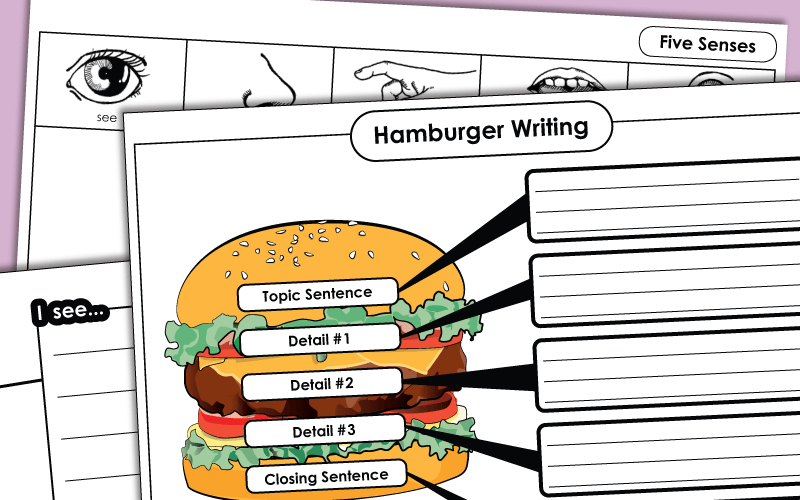
Writing a Paragraph
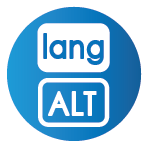
Logged in members can use the Super Teacher Worksheets filing cabinet to save their favorite worksheets.
Quickly access your most used files AND your custom generated worksheets!
Please login to your account or become a member and join our community today to utilize this helpful feature.

Persuasive Writing

Venn Diagrams
Column organizers, concept wheels, relationship trees, question words.
Practice basic writing skills with these writing worksheets.
Printable timeline graphic organizers and timeline comprehension worksheets.
Sample Worksheet Pictures
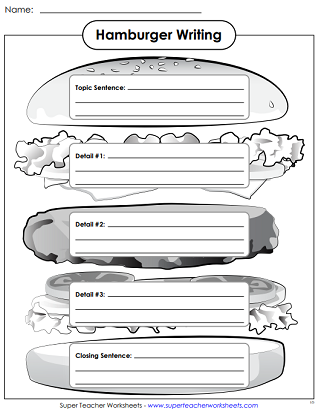
PDF with answer key:
PDF no answer key:
- TemplateLab
Essay Outline Templates
37 outstanding essay outline templates (argumentative, narrative, persuasive).
Writing an essay can seem like an overwhelming task, and planning beforehand is essential to success. An essay outline will help you to structure and organize your essay so that it flows coherently. Essay outlines work for all kinds of essays and will save you time and stress.
There are various different ways to structure an essay, and using an essay outline template allows you to decide on the best structure for your essay. Whether you want a balanced argument, or if you’re trying to persuade someone of your idea, then there will be an essay outline that works for you.
Table of Contents
- 1 Essay Outline Templates
- 2 What is an Essay Outline Template?
- 3 Essay Outline Examples
- 4 What Different Types of Essay Outline Templates Are Available?
- 5 Why are Essay Outlines important?
- 6 How Do You Structure an Outline for an Essay?
- 7 Essay Outline Samples
- 8 What is the Format of a Five-Paragraph Essay Outline?
- 9 How to Write an Effective Essay Outline
- 10 Free Essay Outlines
- 11 Create an Effective Outline Using an Essay Outline Template
You can download and print one of our free essay outline templates to help you plan the perfect essay.
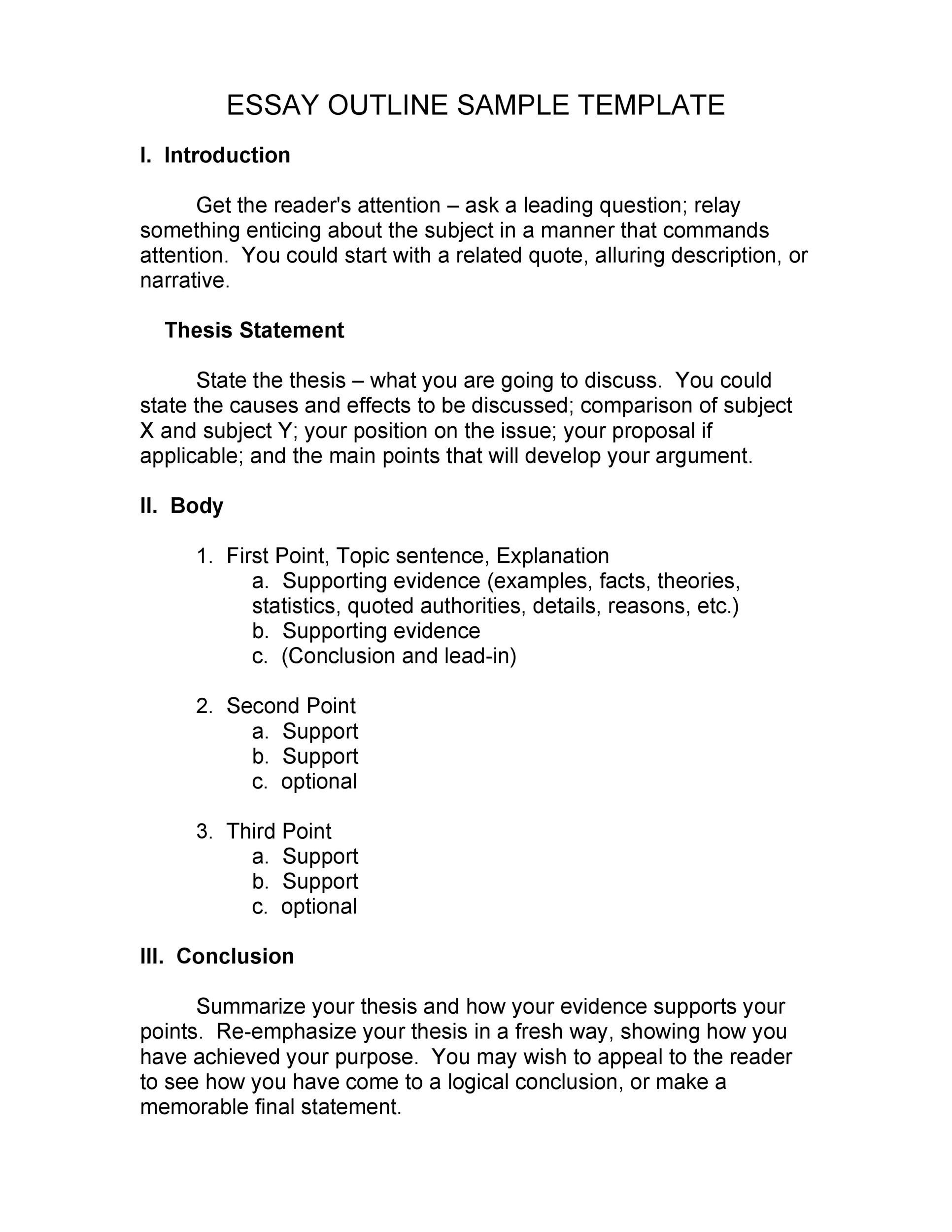
What is an Essay Outline Template?
An essay outline template is essentially the essay plan. It provides students with a clear structure before they write their essay, including all of the main points that are necessary for their writing.
Planning an essay outline beforehand makes the process of essay writing a lot less daunting, providing students with a guideline to follow whilst writing their essays in detail. In the world of academic writing , an essay outline serves as a tool to organize and structure thoughts before delving into the actual writing process. Many students underestimate the significance of creating an essay outline, often resulting in disorganized and incomprehensible essays.
Essay Outline Examples
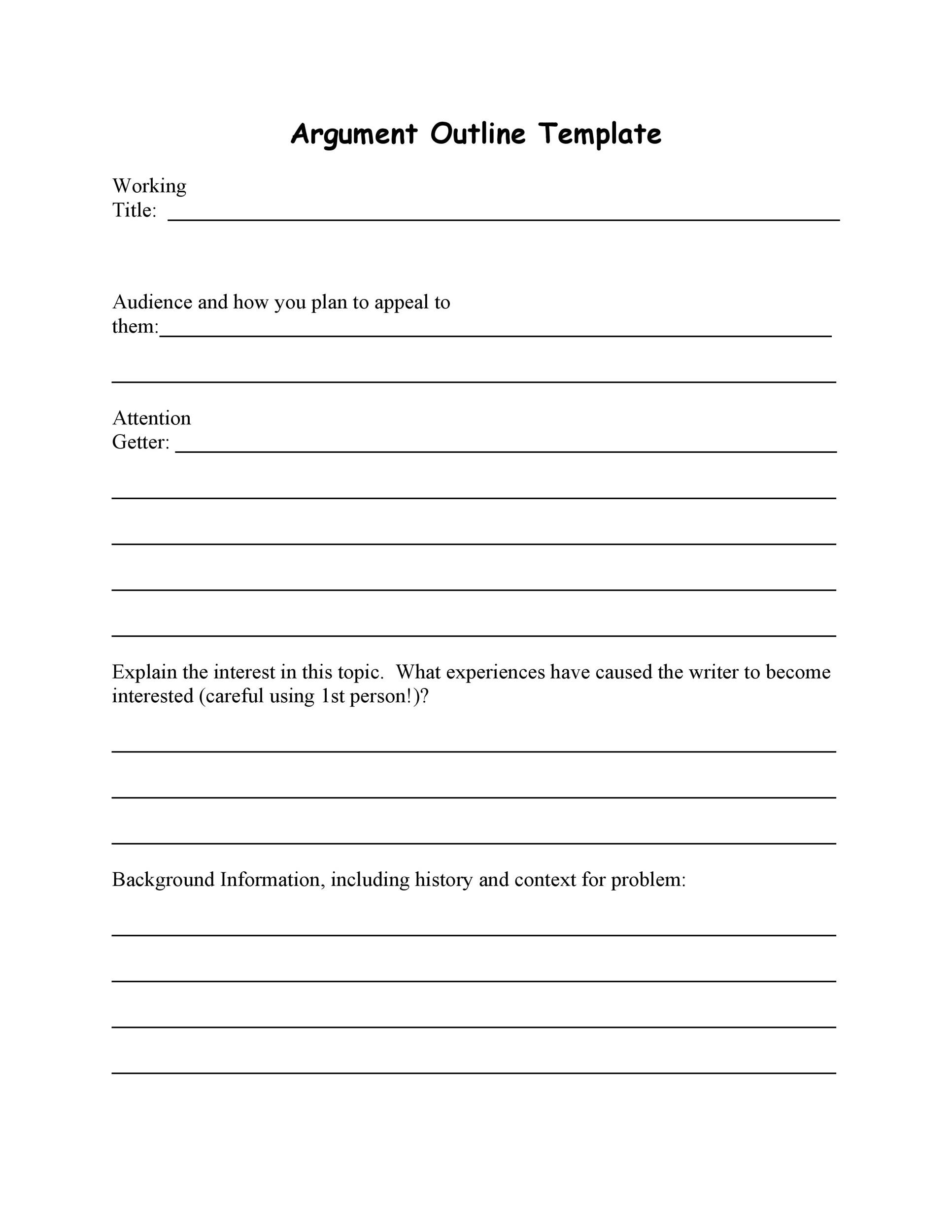
What Different Types of Essay Outline Templates Are Available?
Essay outlines can be used for any college essay, research papers, a contrast essay, speech writing, or an expository essay. There are a range of essay outline templates to use, and they vary depending on the style of essay you are writing. These include:
- Argumentative essay outline
- Narrative essay outline
- Contrast essay outline
- Literary analysis essay outline
- Persuasive essay outline
- Expository essay outline
- College essay outline
- Descriptive essay outline
- Reflective essay outline
Depending on the purpose of your essay, there will be a different structure to suit your writing and your writing process. For example, an argumentative essay outline may follow a more traditional five-paragraph essay outline, while a literary analysis essay may follow a more detailed essay outline template.
Why are Essay Outlines important?
Of course, you can write an essay without planning. However, it will likely read as unstructured and lacking in coherence. Essays that follow an essay outline template present as more well-researched, clearer, and with a thoughtful structure throughout.
- Planning makes perfect If you are writing to argue a point or explore a range of viewpoints, essay outlines are crucial to prepare before you begin writing in detail. Writing should not be an immediate, quick process; the best essays are drafted, re-drafted, edited, and finalized. If you use an essay outline, this will be reflected in the quality of your work. As a teacher, it is clear to me when students have not taken the time to plan their work. Their writing seems messy and rushed. Essay outlines provide structure and balance to any long piece of writing.
- Save time during the writing process Planning is the hard part of essay writing. During the planning process, you will be brainstorming your ideas and cultivating your overall viewpoint or argument. This means that when you come to write the essay, those ideas are already there. All you need to do is formulate them into sentences and paragraphs. An essay outline makes the process of writing the essay itself so much simpler. With the essay outline template, you will have the bulk of your ideas and the structure of your essay there to follow. It will save you time when it comes to writing the essay out in full.
How Do You Structure an Outline for an Essay?
Depending on the assignment, essays can follow a range of structures, and there are many different ways to structure an essay outline.
Before you begin to structure your essay outline, there are a few things to consider:
- Check your assignment guidelines . Your teacher or professor may have specified a certain number of words or pages for the essay, which can affect how you structure it.
- Consider the purpose of the essay. Is it to argue, is it a persuasive essay, or is it to reflect upon something? This will greatly help you to form and structure your essay, as you may need to compare and contrast ideas throughout your writing.
- Who is your audience? If this essay is purely for academic purposes, then your essay may follow a more traditional structure. However, if your essay is for a speech or a college application, then the structure may be more unconventional and include more of your own thoughts and experiences.
While there may be variations in essay outline structures depending on the specific requirements of the assignment, some general guidelines can be followed. You should edit and adjust your essay structure depending on the tone, audience, and purpose of your essay.
Typically, an effective essay outline comprises three primary sections: the introduction, the body paragraphs, and the conclusion. Each of these sections serves a unique purpose and contributes to the overall coherence of the essay.
- Introduction The introduction section of an essay outline introduces the topic and provides relevant background information to engage the reader. It also includes the thesis statement, which presents the main argument or claim of the essay. To structure the introduction in the outline effectively, writers can utilize a hook to grab the reader’s attention, provide context, and end with a strong thesis statement.
- Body Paragraphs The body paragraphs section of the essay outline supports the thesis statement with relevant evidence and arguments. The number of body paragraphs may vary depending on the required length of the essay. However, it is common to have three body paragraphs, each focused on a specific supporting point. In the outline, writers can include subpoints, evidence, and examples for each body paragraph to ensure a coherent and logical flow of ideas.
- Conclusion The conclusion section of the essay outline summarises the main points discussed in the body paragraphs and restates the thesis statement. The conclusion should not be an afterthought in the essay writing process. This part of the essay helps to tie all of your ideas together and is reflective of a well-structured essay. It is crucial to end the essay on a strong note, leaving a lasting impression on the reader. To structure the conclusion in the outline, writers can briefly restate the thesis, review the main points, and provide a final thought or call to action.
Essay Outline Samples
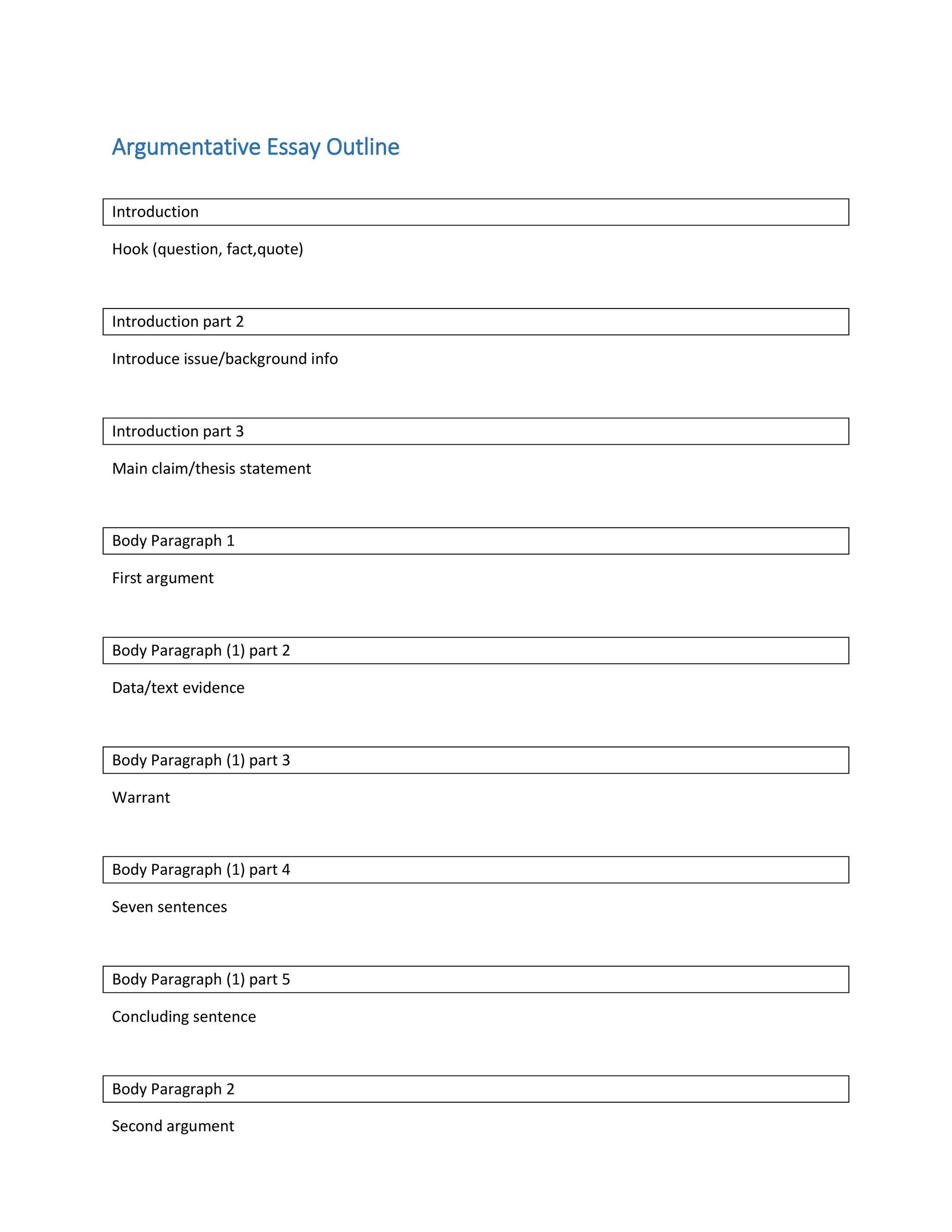
What is the Format of a Five-Paragraph Essay Outline?
A five-paragraph essay outline is a common essay structure used for academic essays. It is particularly useful for shorter essays or beginners who are just starting to develop their writing skills. Many high school students or first-year college students benefit from following this structure.
The format consists of five paragraphs, as the name suggests – an introduction, three body paragraphs, and a conclusion.
- Introduction In the introduction of a five-paragraph essay outline, writers should begin with an attention-grabbing hook to capture the reader’s interest. This can be achieved through a relevant anecdote, a rhetorical question, or a shocking statistic. This helps to immediately capture the reader’s attention and begin the essay strong. Next, provide some background information on the topic and end the introduction with a clear thesis statement that encapsulates the main argument of the essay.
- Body Paragraphs The three body paragraphs of a five-paragraph essay outline each focus on a specific supporting point, which aids in the development of the thesis statement. Start each body paragraph with a topic sentence that introduces the main idea of the paragraph. Following the topic sentence, writers should provide evidence, examples, or arguments to support the main point. It is essential to ensure a logical flow between paragraphs and maintain coherence throughout the essay. This can be done through the use of connectives at the start of each body paragraph, such as ‘Firstly,’ ‘Secondly,’ and ‘Furthermore.’
- Conclusion The conclusion of a five-paragraph essay outline restates the thesis statement and summarizes the main points discussed in the body paragraphs. However, it is vital to avoid introducing new information in the conclusion. Instead, writers should provide a thought-provoking final statement or reinforce the significance of the essay topic.
How to Write an Effective Essay Outline
Each writer will have their own unique approach to essay writing, but preparing an essay outline does not require you to reinvent the wheel. You can follow these simple steps to craft an effective, useful, solid outline.
- Read and Understand the Assignment Before beginning the outline, thoroughly read and understand the essay assignment, including any specific guidelines or requirements from the instructor. This will help in determining the length, topic, and structure of the essay. Understanding the assignment in detail also enables you to plan how you will carry out your preliminary research for the essay. Adaquete reading and preparation also helps you to establish the purpose of your essay, which will determine which essay outline template will work best for you.
- Brainstorm and Organize Ideas Start with brainstorming ideas related to the topic. Here, you should establish the key points of the essay based on your research. Once ideas are generated, you can organize them into meaningful categories or subtopics. In an argumentative essay outline, for example, you will need to compare and contrast ideas. By placing all the main points into categories in an organized manner, you can create a logical flow within the essay, making it more engaging for the reader.
- Choose an Appropriate Outline Format Decide on the outline format that best suits the specific essay requirements. Depending on the complexity of the topic, your essay may be formatted differently. An expository essay will differ from a research paper, for example, so be clear on which outline will work for you. It is also essential to decide on the number of main points to be included based on the required length of the essay. Sometimes it is best to discuss fewer points in greater detail, particularly for a literary analysis or narrative essay.
- Develop Thesis Statement and Main Arguments Craft a strong and clear thesis statement that encapsulates the main argument or claim of the essay. Then, determine the main arguments or supporting points that will be discussed in the body paragraphs.
- Organize Supporting Points and Supporting Evidence Arrange the main arguments in a logical order, keeping in mind the flow of ideas. Ensure that each supporting point is backed up by sufficient evidence or reasoning to strengthen the overall argument. This will also help you to write a strong conclusion to complete your essay.
- Review and Revise After creating the initial essay outline, review and revise it to ensure coherence, logical flow, and adherence to the assignment requirements. Make necessary adjustments and rearrange the outline if needed. Then, you can start writing your essay by following the outline.
Free Essay Outlines
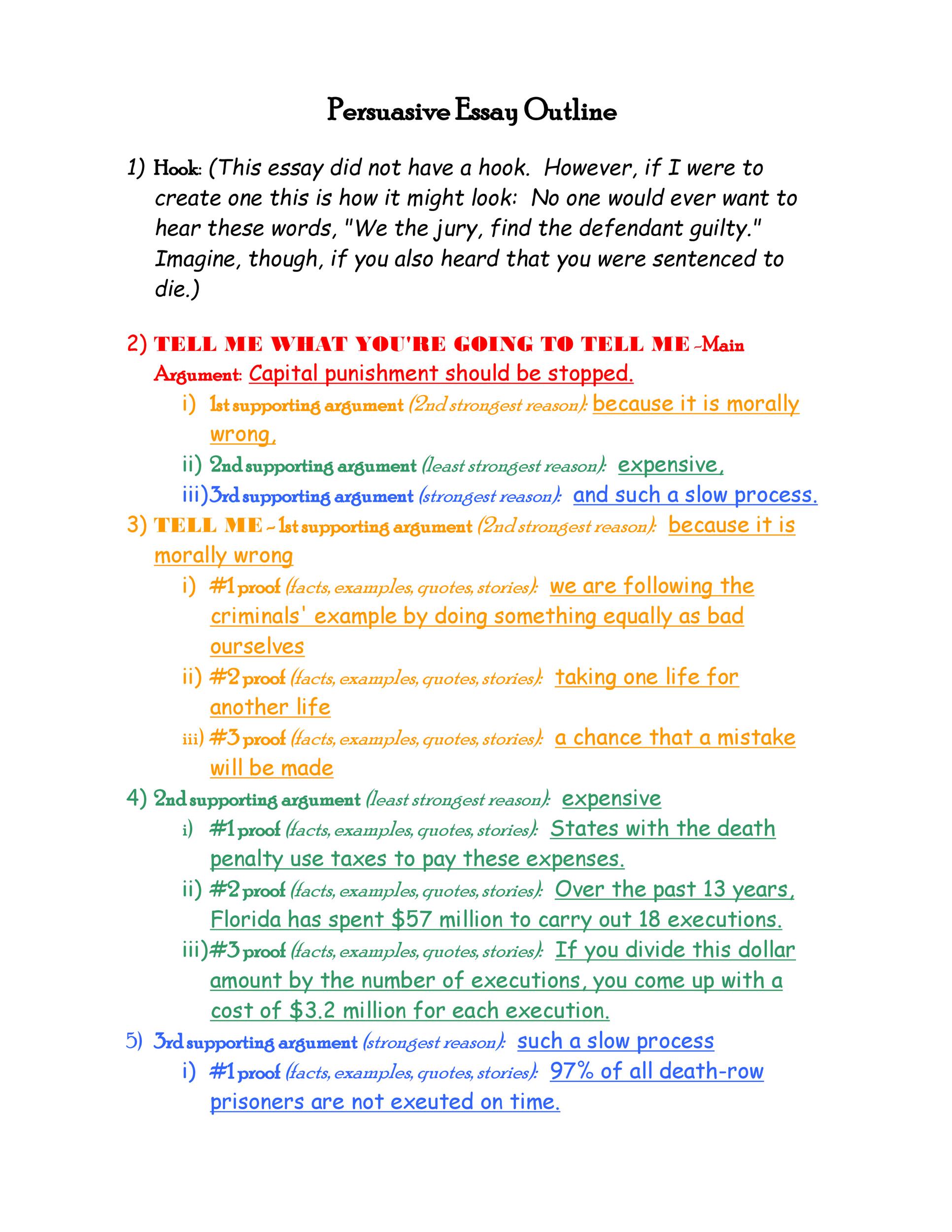
Create an Effective Outline Using an Essay Outline Template
Creating an essay outline is a crucial step in the writing process that should not be overlooked. Whether it’s an argumentative essay outline, a literary analysis essay outline, or a persuasive essay outline, an essay outline template can help you to structure and organize your points in a thoughtful and clear way.
By structuring an essay outline effectively, using the appropriate format for a five-paragraph essay, and following the steps to write an essay outline, writers can ensure a well-organized, coherent, and compelling essay. Utilizing an essay outline template not only enhances the writing quality but also saves time and effort in the long run.
More Templates

Spelling Test Templates

All About Me Templates

Frayer Model Templates

Attendance Sheet Templates

Table of Contents Templates

Literature Review Templates
| > > |
| |
|---|
| to print. Line-by-line color-coded organizer to familiarize students with the nuts and bolts of basic essay-writing and organization. This chart shows students line-by-line how to write an essay. Teachers give students this sheet, and students proceed to fill it in. Once this sheet of essay notes has been completed, students use it to create a five-paragraph essay. This sheet is especially useful with students who have little or no experience with formal writing. Check out more of our free . |
| All materials on this website are © www.studenthandouts.com unless otherwise noted. Please contact us via Facebook or Twitter with any questions. - - - |
| Note: Product links are paid affiliate links. All links are deemed relevant and are not placed merely for profit. Purchase through these links helps to keep this educational website online and free. |

Essay Mapping Tool
Instructions.
Effective writing at university is a process:
Analyse the task → Gather content → Plan → Draft → Edit
This tool may help you to bridge from planning to drafting by helping you arrange your sentences in a logical order. It also provides tips for each component of an essay – the introduction, body, and conclusion. It can be used to improve your understanding of essay writing in general or as a planning tool for one of your university assignments.
Because this tool is for your personal use only, you may decide to write in bullet points, but we recommend full sentences. Once you have filled in each section, a complete essay overview will be generated which can be printed.
1. Introduction
Three paragraphs planning spaces have been provided for you. You can add or delete as necessary.
The purpose of the body is to logically develop the points made in your thesis and outline statements. There are no rules about the number of paragraphs required in assignment, but in general, you are advised to develop one idea per paragraph. This is done with a clear and coherent structure which introduces the topic in a topic sentence, defines or clarifies which aspect of the topic you are going to discuss, develops and supports your discussion and (optionally) concludes your discussion.
A topic sentence generally has two parts. You may refer to the overall essay topic and also introduce the specific aspect you plan to discuss in this paragraph. This is referred to as topic + controlling idea . You can also use a topic sentence to link to or contrast with the previous paragraph. This is an effective strategy to use with the second body paragraph onwards. You may choose to conclude the paragraph with a summary sentence; however, you are advised not to overuse this type of sentence as it may seem repetitious.
Cohesion and coherence refer to how effectively sentences are connected and how smoothly the writing flows. This is not simply achieved by following a logical paragraph structure, but also by using linking words (e.g. however/furthermore/consequently ) and referring words (e.g. this/that/these/those )
When you develop your argument, remember to use a range of support. You can use examples, logical reasoning, speculation, statistics and citations
Paragraph 1
Write the topic and controlling idea (one sentence).
Support your controlling idea using evidence, examples, elaboration or explanations. Do not go off topic. Do use in-text references.
Sum up the paragraph and link to your thesis OR link to the next paragraph (one sentence).
Paragraph 2
Paragraph 3, 3. conclusion.
The purpose of the conclusion is to summarize the key points you have discussed; however, it often contains a paraphrase of the thesis statement. This helps link the whole essay together. A conclusion may also contain a statement which links the essay to the broader topic or suggests a future action.
You can begin with the phrase ' In conclusion, ' but there are other phrases you could consider: In summary/This assignment has…/In this essay, I have… . Avoid Finally/Briefly/
Remember to reference any sources you have used. Refer to CDU Library for more information on referencing.
Introduction
To save as a PDF, click the Print button and then change your printer destination to "Save As PDF".
Scroll for more content
Persuasion Map
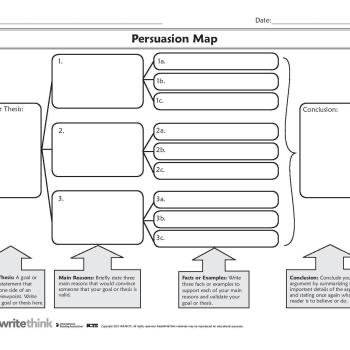
About this printout
Use this graphic organizer to develop a persuasive stance for an essay, speech, poster, or any type of assignment that incorporates persuasion.
Teaching with this printout
More ideas to try, related resources.
Examples of persuasion surround our lives, and the ability to persuade others is a powerful asset. We can persuade people to act in our favor, help them to see our point of view, and sway their opinion to that of our own. The power of persuasion is far reaching, and it is a technique that students will use throughout their lives. This tool helps students formulate ideas for a persuasive argument by helping them determine their goal or thesis, identify three reasons to support it (with three facts or examples to support each reason), and restate the thesis in a conclusion statement. Before your students use this tool independently, model its use for them. Choose a simple topic (such as, “Sixth Grade is the Best Grade” or “Why Our Lunch Period Should be Longer”). Then, fill in the Persuasion Map while discussing the process aloud, displaying the tool so that all students can see it. Review students’ completed maps prior to having them continue with the persuasion assignment. This will provide you with an opportunity to check students’ understanding of persuasion and help those who need extra instruction.
- Have students analyze a persuasive piece (for example, an advertisement or editorial in a newspaper or magazine) by filling in the map and discussing the authors’ strategies of persuasion.
- Encourage older students to create propaganda-based assignments by having them incorporate deceptive language in some of the “reasons” or “examples” on their maps. (Propaganda is a form of persuasion that uses deceptive language to exaggerate, distort, or conceal information.) Upon completion, have students read their maps orally and/or display them for their peers. Have students identify the deceptive language in their peers’ maps to create a class list of the examples used. As an additional follow-up, students can view and read advertisements, newspaper editorials, and other text that contain propaganda to search for use of the examples on the class list and to add additional ones.
- Have students complete two maps based on the same goal but with two different targeted audiences in mind. Attention to audience is an essential element of effective persuasion. For example, students might create maps to market a particular children’s toy; one map could target children as the audience, and the other could focus on parents as the audience. After they have completed their maps, have students read them to the class without identifying the intended audience. Ask the rest of the class to determine the intended audience and identify the specific clues that prompted their deductions. Finally, as a class, compare and contrast the language and words used for each intended audience.
- Lesson Plans
- Student Interactives
- Strategy Guides
Through a classroom game and resource handouts, students learn about the techniques used in persuasive oral arguments and apply them to independent persuasive writing activities.
The Persuasion Map is an interactive graphic organizer that enables students to map out their arguments for a persuasive essay or debate.
- Print this resource
Explore Resources by Grade
- Kindergarten K
Have a language expert improve your writing
Run a free plagiarism check in 10 minutes, generate accurate citations for free.
- Knowledge Base
Methodology
- How to Write a Literature Review | Guide, Examples, & Templates
How to Write a Literature Review | Guide, Examples, & Templates
Published on January 2, 2023 by Shona McCombes . Revised on September 11, 2023.
What is a literature review? A literature review is a survey of scholarly sources on a specific topic. It provides an overview of current knowledge, allowing you to identify relevant theories, methods, and gaps in the existing research that you can later apply to your paper, thesis, or dissertation topic .
There are five key steps to writing a literature review:
- Search for relevant literature
- Evaluate sources
- Identify themes, debates, and gaps
- Outline the structure
- Write your literature review
A good literature review doesn’t just summarize sources—it analyzes, synthesizes , and critically evaluates to give a clear picture of the state of knowledge on the subject.
Instantly correct all language mistakes in your text
Upload your document to correct all your mistakes in minutes

Table of contents
What is the purpose of a literature review, examples of literature reviews, step 1 – search for relevant literature, step 2 – evaluate and select sources, step 3 – identify themes, debates, and gaps, step 4 – outline your literature review’s structure, step 5 – write your literature review, free lecture slides, other interesting articles, frequently asked questions, introduction.
- Quick Run-through
- Step 1 & 2
When you write a thesis , dissertation , or research paper , you will likely have to conduct a literature review to situate your research within existing knowledge. The literature review gives you a chance to:
- Demonstrate your familiarity with the topic and its scholarly context
- Develop a theoretical framework and methodology for your research
- Position your work in relation to other researchers and theorists
- Show how your research addresses a gap or contributes to a debate
- Evaluate the current state of research and demonstrate your knowledge of the scholarly debates around your topic.
Writing literature reviews is a particularly important skill if you want to apply for graduate school or pursue a career in research. We’ve written a step-by-step guide that you can follow below.

Prevent plagiarism. Run a free check.
Writing literature reviews can be quite challenging! A good starting point could be to look at some examples, depending on what kind of literature review you’d like to write.
- Example literature review #1: “Why Do People Migrate? A Review of the Theoretical Literature” ( Theoretical literature review about the development of economic migration theory from the 1950s to today.)
- Example literature review #2: “Literature review as a research methodology: An overview and guidelines” ( Methodological literature review about interdisciplinary knowledge acquisition and production.)
- Example literature review #3: “The Use of Technology in English Language Learning: A Literature Review” ( Thematic literature review about the effects of technology on language acquisition.)
- Example literature review #4: “Learners’ Listening Comprehension Difficulties in English Language Learning: A Literature Review” ( Chronological literature review about how the concept of listening skills has changed over time.)
You can also check out our templates with literature review examples and sample outlines at the links below.
Download Word doc Download Google doc
Before you begin searching for literature, you need a clearly defined topic .
If you are writing the literature review section of a dissertation or research paper, you will search for literature related to your research problem and questions .
Make a list of keywords
Start by creating a list of keywords related to your research question. Include each of the key concepts or variables you’re interested in, and list any synonyms and related terms. You can add to this list as you discover new keywords in the process of your literature search.
- Social media, Facebook, Instagram, Twitter, Snapchat, TikTok
- Body image, self-perception, self-esteem, mental health
- Generation Z, teenagers, adolescents, youth
Search for relevant sources
Use your keywords to begin searching for sources. Some useful databases to search for journals and articles include:
- Your university’s library catalogue
- Google Scholar
- Project Muse (humanities and social sciences)
- Medline (life sciences and biomedicine)
- EconLit (economics)
- Inspec (physics, engineering and computer science)
You can also use boolean operators to help narrow down your search.
Make sure to read the abstract to find out whether an article is relevant to your question. When you find a useful book or article, you can check the bibliography to find other relevant sources.
You likely won’t be able to read absolutely everything that has been written on your topic, so it will be necessary to evaluate which sources are most relevant to your research question.
For each publication, ask yourself:
- What question or problem is the author addressing?
- What are the key concepts and how are they defined?
- What are the key theories, models, and methods?
- Does the research use established frameworks or take an innovative approach?
- What are the results and conclusions of the study?
- How does the publication relate to other literature in the field? Does it confirm, add to, or challenge established knowledge?
- What are the strengths and weaknesses of the research?
Make sure the sources you use are credible , and make sure you read any landmark studies and major theories in your field of research.
You can use our template to summarize and evaluate sources you’re thinking about using. Click on either button below to download.
Take notes and cite your sources
As you read, you should also begin the writing process. Take notes that you can later incorporate into the text of your literature review.
It is important to keep track of your sources with citations to avoid plagiarism . It can be helpful to make an annotated bibliography , where you compile full citation information and write a paragraph of summary and analysis for each source. This helps you remember what you read and saves time later in the process.
Don't submit your assignments before you do this
The academic proofreading tool has been trained on 1000s of academic texts. Making it the most accurate and reliable proofreading tool for students. Free citation check included.

Try for free
To begin organizing your literature review’s argument and structure, be sure you understand the connections and relationships between the sources you’ve read. Based on your reading and notes, you can look for:
- Trends and patterns (in theory, method or results): do certain approaches become more or less popular over time?
- Themes: what questions or concepts recur across the literature?
- Debates, conflicts and contradictions: where do sources disagree?
- Pivotal publications: are there any influential theories or studies that changed the direction of the field?
- Gaps: what is missing from the literature? Are there weaknesses that need to be addressed?
This step will help you work out the structure of your literature review and (if applicable) show how your own research will contribute to existing knowledge.
- Most research has focused on young women.
- There is an increasing interest in the visual aspects of social media.
- But there is still a lack of robust research on highly visual platforms like Instagram and Snapchat—this is a gap that you could address in your own research.
There are various approaches to organizing the body of a literature review. Depending on the length of your literature review, you can combine several of these strategies (for example, your overall structure might be thematic, but each theme is discussed chronologically).
Chronological
The simplest approach is to trace the development of the topic over time. However, if you choose this strategy, be careful to avoid simply listing and summarizing sources in order.
Try to analyze patterns, turning points and key debates that have shaped the direction of the field. Give your interpretation of how and why certain developments occurred.
If you have found some recurring central themes, you can organize your literature review into subsections that address different aspects of the topic.
For example, if you are reviewing literature about inequalities in migrant health outcomes, key themes might include healthcare policy, language barriers, cultural attitudes, legal status, and economic access.
Methodological
If you draw your sources from different disciplines or fields that use a variety of research methods , you might want to compare the results and conclusions that emerge from different approaches. For example:
- Look at what results have emerged in qualitative versus quantitative research
- Discuss how the topic has been approached by empirical versus theoretical scholarship
- Divide the literature into sociological, historical, and cultural sources
Theoretical
A literature review is often the foundation for a theoretical framework . You can use it to discuss various theories, models, and definitions of key concepts.
You might argue for the relevance of a specific theoretical approach, or combine various theoretical concepts to create a framework for your research.
Like any other academic text , your literature review should have an introduction , a main body, and a conclusion . What you include in each depends on the objective of your literature review.
The introduction should clearly establish the focus and purpose of the literature review.
Depending on the length of your literature review, you might want to divide the body into subsections. You can use a subheading for each theme, time period, or methodological approach.
As you write, you can follow these tips:
- Summarize and synthesize: give an overview of the main points of each source and combine them into a coherent whole
- Analyze and interpret: don’t just paraphrase other researchers — add your own interpretations where possible, discussing the significance of findings in relation to the literature as a whole
- Critically evaluate: mention the strengths and weaknesses of your sources
- Write in well-structured paragraphs: use transition words and topic sentences to draw connections, comparisons and contrasts
In the conclusion, you should summarize the key findings you have taken from the literature and emphasize their significance.
When you’ve finished writing and revising your literature review, don’t forget to proofread thoroughly before submitting. Not a language expert? Check out Scribbr’s professional proofreading services !
This article has been adapted into lecture slides that you can use to teach your students about writing a literature review.
Scribbr slides are free to use, customize, and distribute for educational purposes.
Open Google Slides Download PowerPoint
If you want to know more about the research process , methodology , research bias , or statistics , make sure to check out some of our other articles with explanations and examples.
- Sampling methods
- Simple random sampling
- Stratified sampling
- Cluster sampling
- Likert scales
- Reproducibility
Statistics
- Null hypothesis
- Statistical power
- Probability distribution
- Effect size
- Poisson distribution
Research bias
- Optimism bias
- Cognitive bias
- Implicit bias
- Hawthorne effect
- Anchoring bias
- Explicit bias
A literature review is a survey of scholarly sources (such as books, journal articles, and theses) related to a specific topic or research question .
It is often written as part of a thesis, dissertation , or research paper , in order to situate your work in relation to existing knowledge.
There are several reasons to conduct a literature review at the beginning of a research project:
- To familiarize yourself with the current state of knowledge on your topic
- To ensure that you’re not just repeating what others have already done
- To identify gaps in knowledge and unresolved problems that your research can address
- To develop your theoretical framework and methodology
- To provide an overview of the key findings and debates on the topic
Writing the literature review shows your reader how your work relates to existing research and what new insights it will contribute.
The literature review usually comes near the beginning of your thesis or dissertation . After the introduction , it grounds your research in a scholarly field and leads directly to your theoretical framework or methodology .
A literature review is a survey of credible sources on a topic, often used in dissertations , theses, and research papers . Literature reviews give an overview of knowledge on a subject, helping you identify relevant theories and methods, as well as gaps in existing research. Literature reviews are set up similarly to other academic texts , with an introduction , a main body, and a conclusion .
An annotated bibliography is a list of source references that has a short description (called an annotation ) for each of the sources. It is often assigned as part of the research process for a paper .
Cite this Scribbr article
If you want to cite this source, you can copy and paste the citation or click the “Cite this Scribbr article” button to automatically add the citation to our free Citation Generator.
McCombes, S. (2023, September 11). How to Write a Literature Review | Guide, Examples, & Templates. Scribbr. Retrieved June 7, 2024, from https://www.scribbr.com/dissertation/literature-review/
Is this article helpful?
Shona McCombes
Other students also liked, what is a theoretical framework | guide to organizing, what is a research methodology | steps & tips, how to write a research proposal | examples & templates, what is your plagiarism score.

IMAGES
VIDEO
COMMENTS
Creating graphic organizer templates with Google Drawings. As Amy mentioned above, Google Slides can be used to create these as well as Google Drawings. ... Helps students organize essays by breaking down parts of the essay in different sections. (submitted by Melissa Rasmus of Chippeway Falls Area USD in Wisconsin) Google Drawing Template.
Brainstorm Chart. Concept Map. 5-Paragraph Essay Outline. 4 Square Writing Chart. Story Map. KWL Chart. 1. Flowchart. The Flowchart is one of the most versatile and recognizable forms of graphic organizer out there, ideal for project planning and science experiments.
Example 3: Argumentative Essay Graphic Organizer. This template solemnly deals with the expository template of the essay. It focuses on the essay's three most basic parts: the introduction, body, and conclusion. Moreover, the writer evaluates the selected topic in it with examples and evidence and closes the argument clearly and concisely.
1,245 templates. Create a blank Graphic Organizer. colorful playful creative main idea Graphic organizer. Graphic Organizer by Olmos Carlos. Frayer Diagram Graphic Organiser in Blue White Simple Style. Graphic Organizer by Education Resource Hub. Beige and Yellow Floral Illustrative Ideas Graphic Organizer.
Use this graphic organizer to plan your analytical/persuasive essay. The introduction should start with a broad statement and end with your thesis statement, which "zooms in" on the points you will explore in more depth. The body paragraphs must contain evidence to support your thesis. (The number of body paragraphs coincides with the ...
Helps you visualize your research and how elements connect with each other. Enhance your essays, summaries and research papers with visual elements. Track correlations between your thoughts, observations, facts or general ideas. When it comes to essay writing, the most common graphic organizers are webs, mind maps, and concept maps.
Students can use a graphic organizer for writing an essay, creating a story map, or studying a scientific concept. ... Canva's graphic organizer templates are your shortcut to a good-looking chart or diagram. Simply choose a template, and use our design tools to create your graphic organizers. Start with one of the beautiful templates below.
The basic structure of an essay always consists of an introduction, a body, and a conclusion. But for many students, the most difficult part of structuring an essay is deciding how to organize information within the body. This article provides useful templates and tips to help you outline your essay, make decisions about your structure, and ...
In Lucidchart, our mind map shapes and templates double as brainstorming graphic organizers. Start with an essay prompt as your central shape and then fill in the shapes that branch off your prompt with topic ideas. Alternatively, you can add your selected topic to the center and start brainstorming the different ideas you need to cover in your ...
Use Essay Map to plan and organize your essays with an interactive graphic organizer. Learn expository writing skills and improve your grades.
January 20, 2021. 2 Min Read. Help your students classify ideas and communicate more effectively with these free graphic organizer templates, available for download. They can be used to structure writing projects and help in problem solving, decision making, studying, planning research, and brainstorming.
The Persuasion Map is an interactive graphic organizer that enables students to map out their arguments for a persuasive essay or debate. Students begin by determining their goal or thesis. They then identify three reasons to support their argument, and three facts or examples to validate each reason. The map graphic in the upper right-hand ...
Hamburger Paragraph Writing. Version 3. This is yet another version on the hamburger writing activity. This organizer has the hamburger parts spread out. If you'd like to print this worksheet in full-color, use the "Alt" button below. 2nd and 3rd Grades. View PDF. Writing a Paragraph - Flower (no lines) FREE.
Grades. 3 - 12. Launch the tool! Expository writing is an increasingly important skill for elementary, middle, and high school students to master. This interactive graphic organizer helps students develop an outline that includes an introductory statement, main ideas they want to discuss or describe, supporting details, and a conclusion that ...
Essay outlines can be used for any college essay, research papers, a contrast essay, speech writing, or an expository essay. There are a range of essay outline templates to use, and they vary depending on the style of essay you are writing. These include: Argumentative essay outline. Narrative essay outline. Contrast essay outline.
Revised on July 23, 2023. An essay outline is a way of planning the structure of your essay before you start writing. It involves writing quick summary sentences or phrases for every point you will cover in each paragraph, giving you a picture of how your argument will unfold. You'll sometimes be asked to submit an essay outline as a separate ...
There are no set rules for how to structure a college application essay, but you should carefully plan and outline to make sure your essay flows smoothly and logically. Typical structural choices include. a series of vignettes with a common theme. a single story that demonstrates your positive qualities. Although many structures can work, there ...
Graphic Organizer for a Five-Paragraph Essay Paragraph 1: Introduction Paragraph 2: First Body Paragraph (Point 1) Paragraph 3: Second Body Paragraph (Point 2) Paragraph 4: Third Body Paragraph (Point 3) Paragraph 5: Conclusion Topic Sentenc e: Supporting Details : Topic Sentence: Supporting Details : Topic Senten ce: Supporting Details :
Line-by-line color-coded organizer to familiarize students with the nuts and bolts of basic essay-writing and organization. This chart shows students line-by-line how to write an essay. Teachers give students this sheet, and students proceed to fill it in. Once this sheet of essay notes has been completed, students use it to create a five-paragraph essay.
Analyse the task → Gather content → Plan → Draft → Edit. This tool may help you to bridge from planning to drafting by helping you arrange your sentences in a logical order. It also provides tips for each component of an essay - the introduction, body, and conclusion. It can be used to improve your understanding of essay writing in ...
Offer some more specific background information (as needed). 3. Provide the title of the piece and the author's name if the essay is about a specific book/poem/article/passage. C. Thesis Statement 1. State your topic and position. Remember that a thesis = claim + reasons. 2. Outline your main points and ideas.
General Background Information (1-2 sentences) i. Attention grabbing intro. ii. Who, What, When, Where - establish topic. b. Write your Thesis Statement. i. an arguable sentence, which is debatable and worth proving. c. Summarize Body Paragraph Sub-points / Arguments (1 sentence)
Use this graphic organizer to develop a persuasive stance for an essay, speech, poster, or any type of assignment that incorporates persuasion. Teaching with this printout ; More ideas to try ... The Persuasion Map is an interactive graphic organizer that enables students to map out their arguments for a persuasive essay or debate. Grades . 6 - 12
Examples of literature reviews. Step 1 - Search for relevant literature. Step 2 - Evaluate and select sources. Step 3 - Identify themes, debates, and gaps. Step 4 - Outline your literature review's structure. Step 5 - Write your literature review.